The post Feeling Tiny In Colombia’s Tayrona National Park appeared first on The Expeditioner Travel Site.
]]>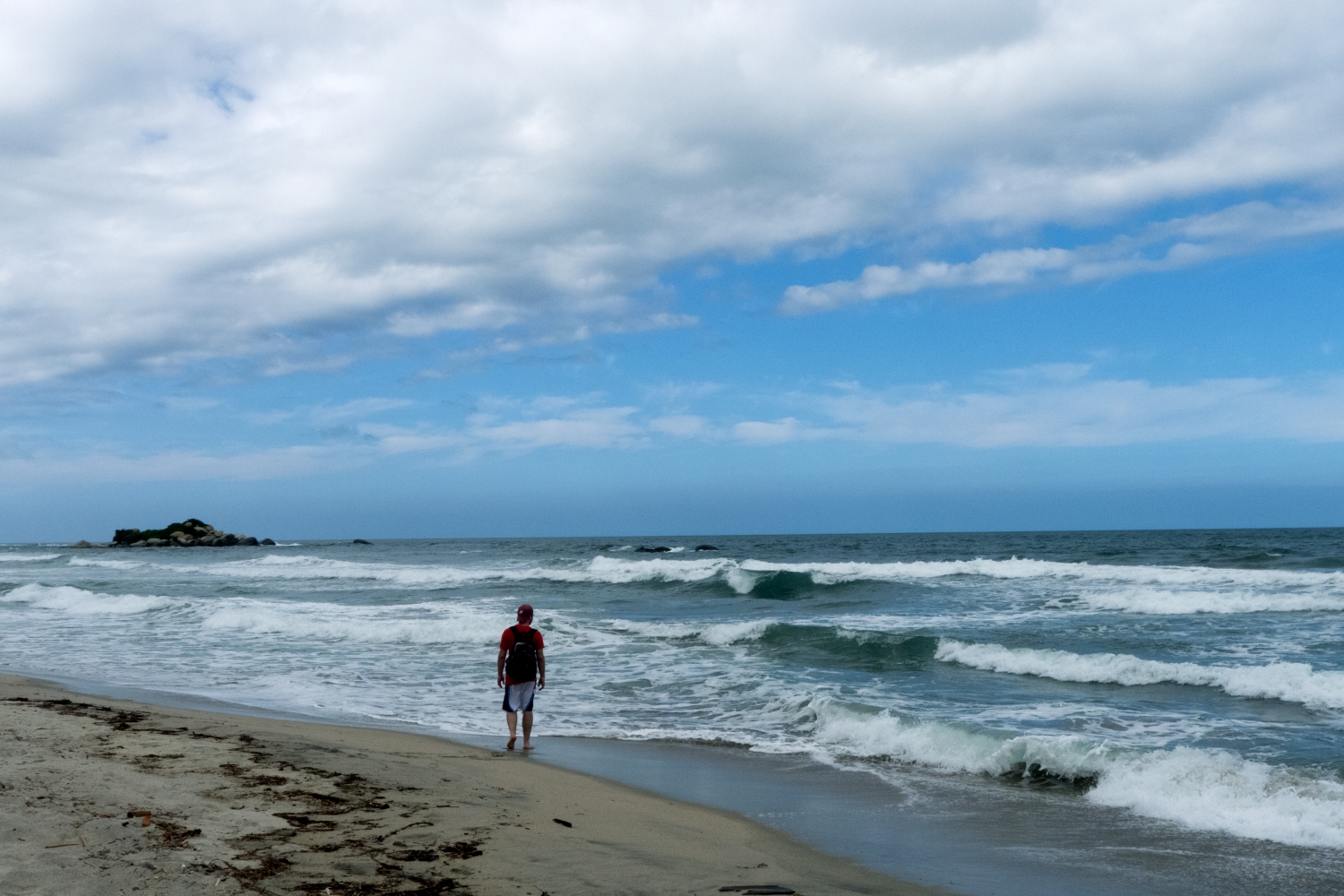
We stood at the entrance to a lush, tropical forest and confronted a simple yet profound choice. Do we proceed on foot, hauling our backpacks in the already thick morning air, or do we pay a local for the pleasure of mounting a time-worn horse?
We picked the budget option and started the hour-long walk into Parque Tayrona, a protected stretch of the Caribbean coast in Colombia. The park, which is really a beach cleaved from the outside world by dense forest, attracts a steady stream of foreign backpackers and appreciative locals. But even with nearly 300,000 people per year stopping by, it doesn’t feel crowded.
Or at least it didn’t in November 2011, when I visited there with an old friend and longtime traveling companion, Will. We had been friends since college where we bonded over spiced rum and grunge rock, and where later reached bro-for-life status when we both ended up in New York City after graduation. We had already road-tripped down the East Coast to New Orleans and across Southern France and Spain. Now we were in Colombia for a few weeks.
This may not be true for everyone, but I find I can divide travel into two types of experiences: city exploration and nature excursions (the guidebooks seem to back me up on this). We tried to mix things up, going from the intimidating urban sprawl of Bogota to a place called Valle del Cocora, where lanky Andean palm trees grow more than 100 feet in the air, making the humans underfoot look very insignificant. From there, we hit up some mountain-top thermal baths before partying in Medellin and Cartagena.
The time had come to refresh the soul (and the liver). Hence, to Tayrona.
The great part about Colombia is that two weeks actually do give you enough time to hop and skip your way across the country, even if you take the buses as we did. From Medellin, we downed some almost-too-easy-to-procure sleeping pills and took a mind-bending 24-hour bus ride to Cartagena. I fell into a dope-induced stupor but can recall images of Will vomiting into a small plastic bag (pills + switchback turns = regrettable mistake) and I believe I spoke sharply at the young boy sitting behind us, who was picking my pocket in a dream world.
We arrived just in time for Carnival festivities.
The scene was festive and chaotic: the locals packed the streets of an old, weathered neighborhood outside the city proper, sipping from small bottles of aguardiente, Colombia’s national paint remover, and squirting the gringos (us) with aerosol cans of foam and bags of water. Every now and then, someone would throw a deafening firework in our direction.
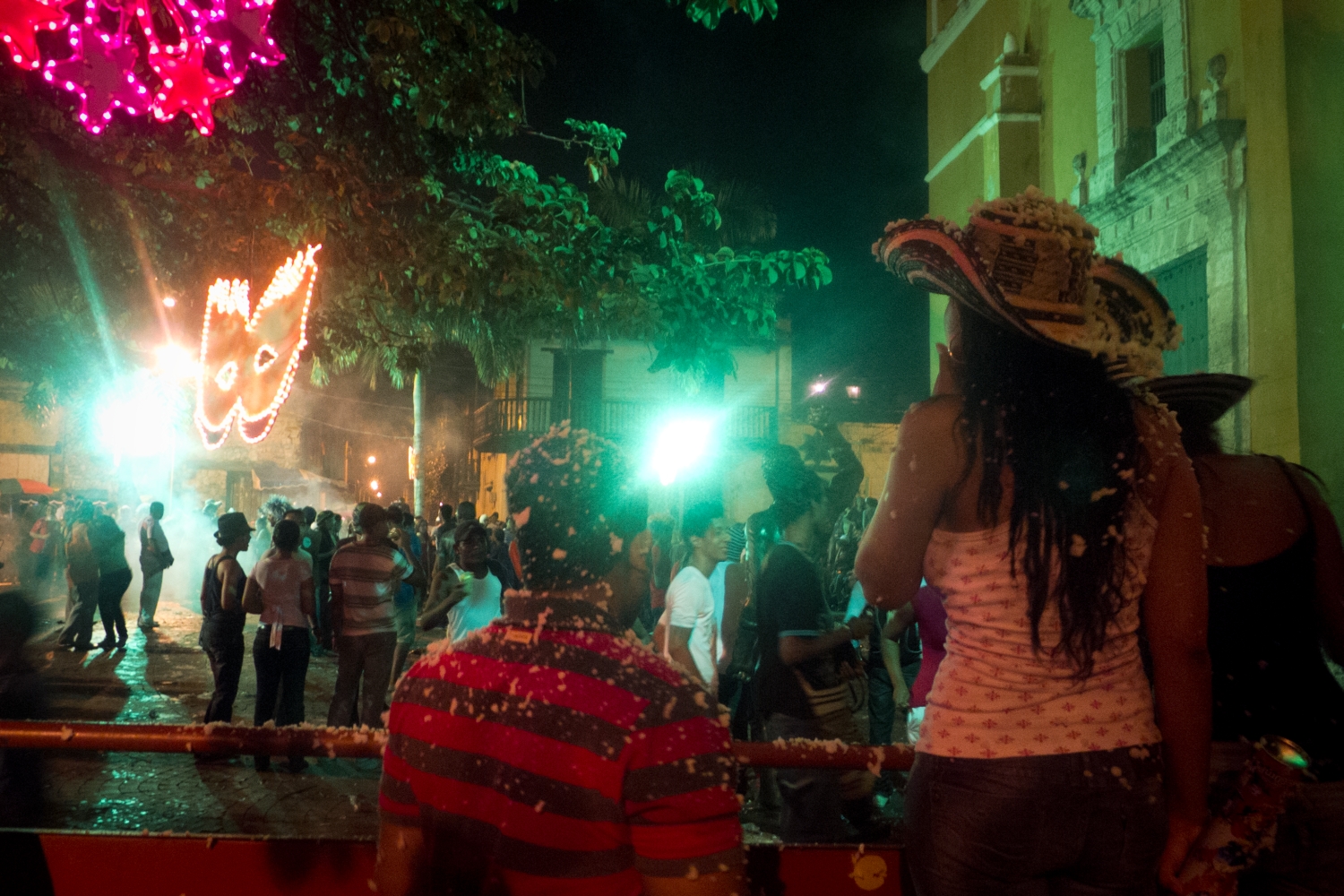
Somewhere on the spectrum of foam facial to flashbang, Will’s tolerance broke and he turned back for the hotel. I stayed out and danced in the streets with some German guys and a group of Colombian 20-somethings until one of the Germans got in fight with a hot dog vendor and it seemed wise to slink away to the hotel (after buying a hot dog myself, from a separate vendor).
We both felt pretty tapped out the next morning when we hopped onto another bus, this one to Santa Marta, a colonial city further up the coast that serves as a jumping-off point for Tayrona. We had probably hit the point of the trip where we were a little tired of each other, so a beach with no agenda seemed like a good idea.
The only issue was that it was Will’s birthday. I wasn’t about to sing to him on a moonlit beach or anything. But we were in our 30’s. I assumed it didn’t matter much to him.
The hike into the park was more challenging than expected. This was November and it had been raining a good deal, so the path was sometimes more mud than solid ground. The mounted travelers seemed to mock us even in their absence, since the path had been beaten down with the regular mash of hooves and repaved with horse shit.
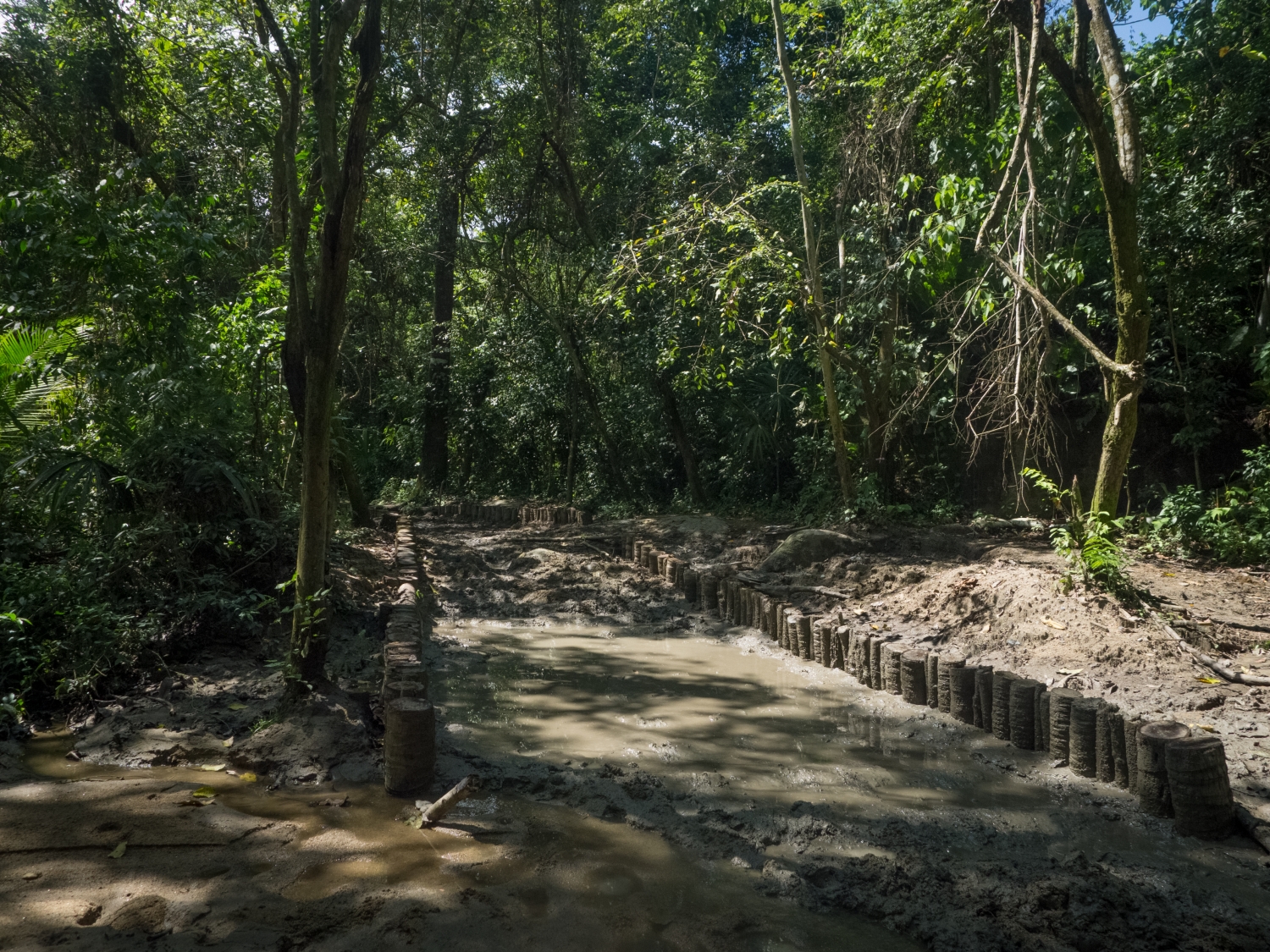
We stopped for a few breathers (the humidity!) and took in the surroundings. On the ground, a river of tiny green leaves moved up the path, carried by industrious leafcutter ants. We followed it with our eyes and the train of ants extended a long, long way.
My daily commute at the time wasn’t much different. I was working in the New York suburbs, wrestling with Long Island traffic on a daily basis, struggling to make rent, and feeling a lot like one of these tiny laborers. Presumably the ants weren’t gathering the preparations for a keg party.
Will, on the other hand, worked as a software engineer and spent the winter months away from New York, typically somewhere south of Texas. I can’t recall seeing an insect that would serve as a stand-in for his lifestyle, but maybe there’s some sort of dragonfly out there that fits the bill.
A little while later we reached the beach, ready to put down our things and take a dip. We passed several cabins, thinking it would be best to stay closer to the water, and eventually stopped at a beach campsite. A guy named Carlos came and greeted us. He showed us around the site, which consisted of an open-air pavilion with a television and tables for dining, as well as a sleeping area — a thick tree trunk with 8 or 10 hammocks ringing it like a pinwheel.
He said to throw our stuff in whichever hammock we wanted to sleep in. The cost was around $5 for the night. Easy enough.
We changed into our bathing suits and listened to Carlos riff on American politics (not a fan of George W. Bush . . . go figure) before we left for the water.
I’ve never felt that words are the best way to describe a landscape, especially if photos are available. But I would say this: the beauty of Tayrona felt both serene and brutal. The roar of the surf hit you first, but the surroundings stole the scene. The beach was ringed by a palm-studded forest that might remind an ignorant American (like me) of a movie about the Vietnam War. I imagined fleeing in a chopper while my compatriots zoomed by in fighter jets, setting off fiery explosions around me.
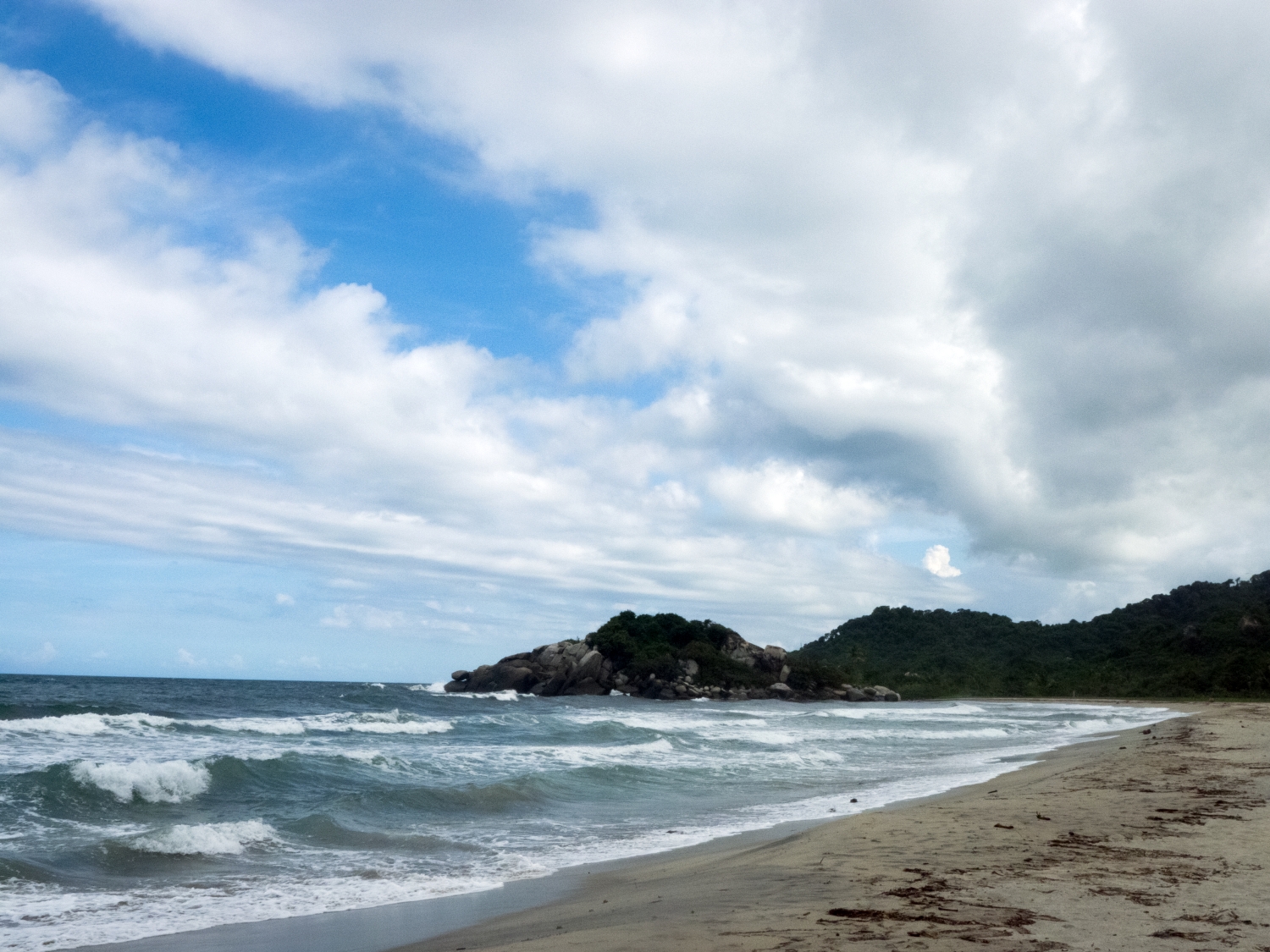
Gray boulders the size of a family sedan sat at the edge of the water — they weren’t going anywhere for a long, long time. We waded into the water up to our knees, but not much more. Carlos had told us not to swim near the campsite and one mention of the word “drown” was all I needed to hear.
We wandered down the beach, not saying much. What was there to say? This place was overwhelming. Everything was so alien to our daily lives, which were largely spent at keyboards (or in my case, in traffic). Through the trip, Will had been the photographer, but for a moment, we swapped roles and I snapped photos of him as he climbed onto one of these massive boulders. Something about those rocks made me think about the universe and whether it viewed me as anything more than a flimsy leaf struggling to hang on for another day.
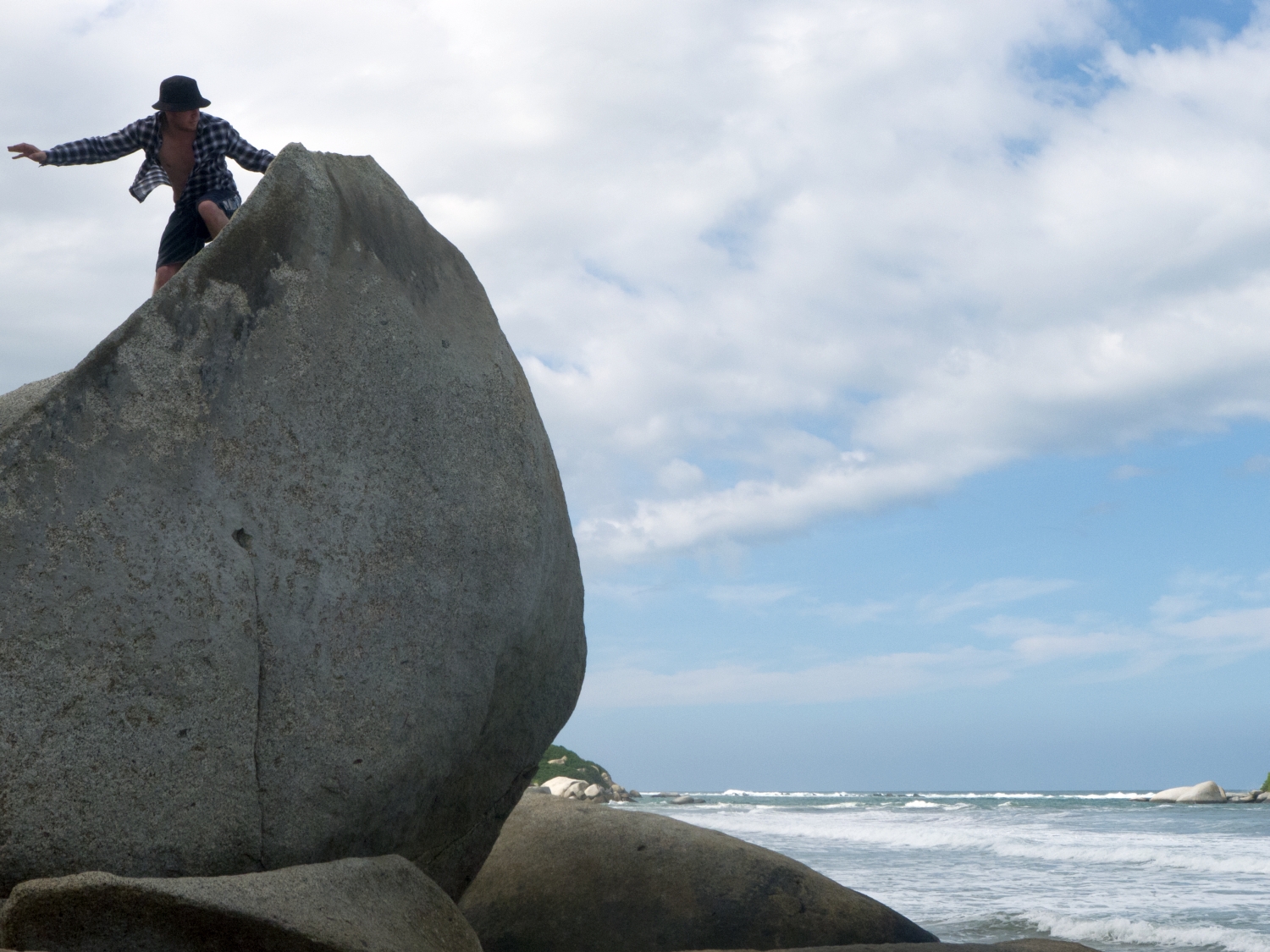
There was supposed to be a swimming beach somewhere down the coastline, but even after a decent walk, we couldn’t find it. The beach seemed to end; we ran into a wall of rock and palm trees. After wandering in muddy forest for 30 minutes or so, we backtracked and got directions from some German tourists.
The swimming beach was pristine and, at this point, a near-necessity, what with the sweating and exasperated tromping through coastal muck and such. The water shimmered the cool blue of a mellow mouthwash. We waded in.
And here’s another thing: it was nearly deserted. A pair of slim women stood down-beach, out of earshot. We didn’t swim out too far (again, the drowning thing) but it didn’t matter. This beach wasn’t for working out, it was for enjoying.
A long while passed there in the water. We eventually chatted with the women, who were both models, one retired, one still in the business. The retired one now owned a bar in Santa Marta and invited us to stop by when we got back to town.
We walked further into the park and reached a sort of mega-campsite where it appeared most of the backpackers flocked to see the sun rise in the morning. We didn’t stay here too long. The sun was still shining brightly, but it was past its peak.
When we returned to our camp, it was nearly dinnertime. We rested a bit in the hammocks and then sat down to eat. Carlos wasn’t around, but another guy running the kitchen brought me an enormous fried fish that made me very happy. While we ate, the other 7 or 8 guys watched a comedy show on the television.
After dinner, there wasn’t much to do. We wandered around a bit, looking for the type of unexpected off-the-hook party you might find in a beer commercial. No dice.
Instead, we made our way back to the campsite. The other guys staying there seemed to be laborers — I saw a couple of them cutting down a tree during the day — and they were watching a hard-core porno. We settled down into our hammocks to the sound of an enthusiastic gangbang.
Sometime later, everyone went to sleep. Will couldn’t nod off and asked if I wanted to head to the beach. Normally, I might have taken him up on the offer, but we were under mosquito nets on our hammocks and I deceived myself into thinking I might actually fall asleep. I told him to go ahead.
In the morning, I woke up to the sound of some chickens who clearly didn’t understand their place on the food chain. My ankles were itchy and when I rolled out of the hammock, I saw a solar system of red bumps around my knee.
I took a piss on the outskirts of the camp, near a blank-faced donkey. Everyone else was awake and gone except Will, who slept a bit longer. When he woke up, he was talking about the night before.
“It’s weird. It was like the best and worst way to celebrate a birthday,” he said.
“Oh yeah, happy birthday,” I replied.
He muttered something dismissive and went on with the story.
“There was lightning across the beach, no one out there. It was the most amazing shit I’ve ever seen in my life,” he said. “But then on the flip side, when I got back to this shitty-ass hammock, 5 dudes are fucking snoring like a symphony.”
I mentioned the red dots.
“Oh shit, you have those too?”
Will took a picture on the beach that night. There we were: standing on the edge of a continent. A storm rolled past. Waves maintained their endless roar. After the storm, there was a dazzling display of stars.
In this setting, we barely existed.
We hiked out of Tayrona and returned to Santa Marta, where we met the bar owner and her friend for drinks. We nursed whiskeys in an open-air courtyard and chatted with our new-found acquaintances and the handful of patrons.
I wondered about Will’s birthday: did he care that we spent it on a remote beach instead of downing shots in Medellin? Was I a bad friend for not taking these details into consideration? Tayrona was almost anti-birthday in a way, the sort of place where you seem very insignificant in the grand scheme of things. I decided not to worry about it.
The red dots on our legs kept itching for a few days. As it turned out, they were flea bites.

Photos by Will Benedict
/
 Ted Hesson is a multimedia journalist based in Washington, D.C. For more of his work, visit TedHesson.com.
Ted Hesson is a multimedia journalist based in Washington, D.C. For more of his work, visit TedHesson.com.
The post Feeling Tiny In Colombia’s Tayrona National Park appeared first on The Expeditioner Travel Site.
]]>The post Here’s What It Was Like Attending Colombia’s Craziest Festival appeared first on The Expeditioner Travel Site.
]]>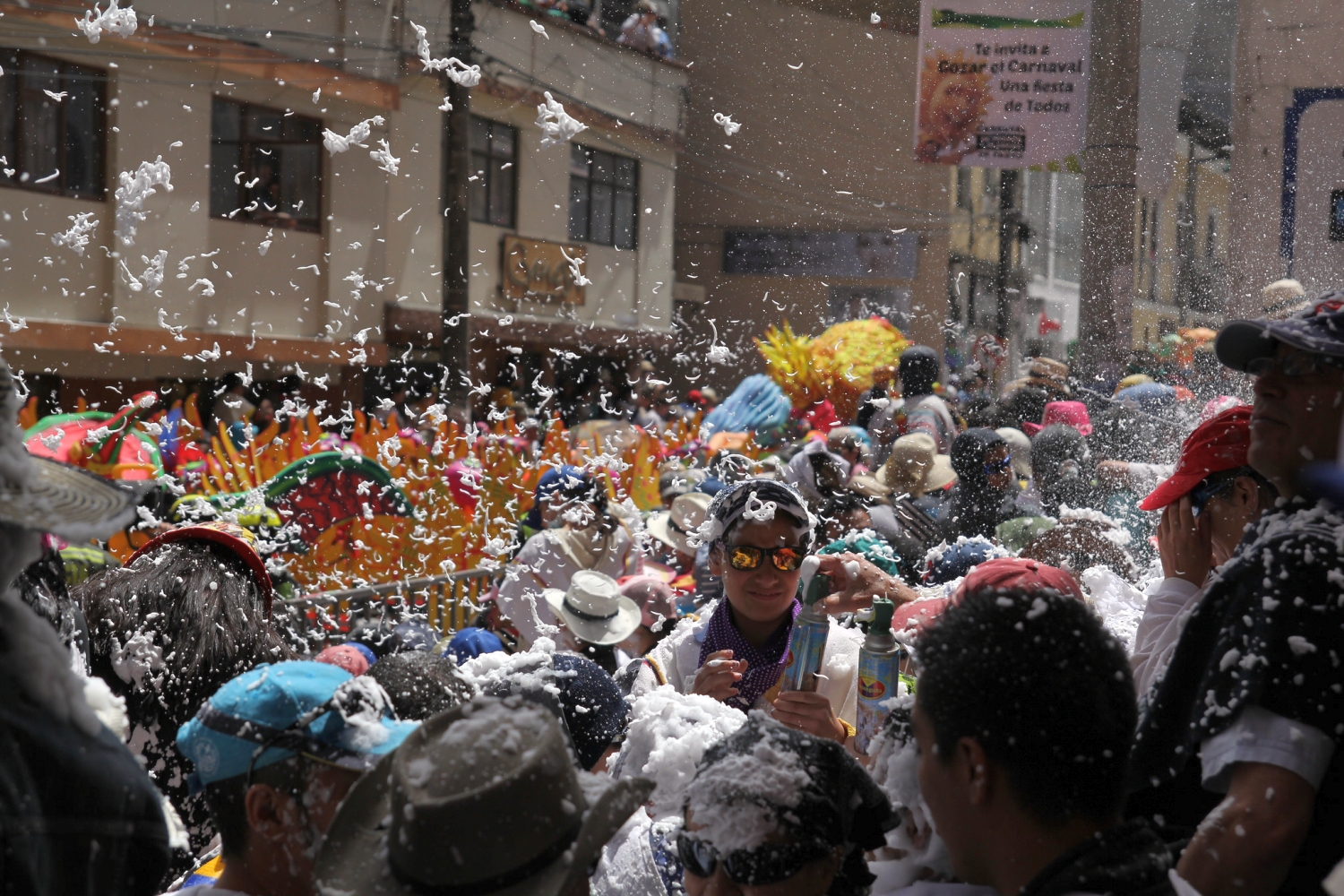
All the babies are crying, and an old lady starts yelling hysterically. As an enormous burst of turbulence turns my stomach sideways, I catch the eye of a man who looks like Gabriel Garcia Marquez. He gives me a gruff nod and half-smile, as if to assure me that the landing is always like this. I’m not convinced. Looking out the windows on both sides, men shout distances up to the cockpit, as if they were helping a neighbor parallel park. “10 meters!” “15 meters!” They are estimating the distance between the wingtips and the green peaks of the Andes. And the numbers they’re using are disturbingly small.
Though it wasn’t in the brochure, this is my introduction to the three-day, non-stop adrenaline rush that is the famous Carnaval de Negros y Blancos. Shaking a little bit, I step out into the one-plane airport of Pasto, Colombia, very near the Ecuadorian border. Now that they no longer herald a death stung by bits of fiery fuselage, the Andes are really quite beautiful. I even start to relax as I pass through the tiny terminal to the taxi stand. But there’s an ambush in place outside the airport. A group of teenagers cackle as they strafe the line of expectant family members and private taxi services, each armed with two cariocas, the basic-issue armament of the Carnaval participant. They are long, narrow aluminum cans containing something akin to shaving cream. I duck behind an old woman who takes the brunt of the fire. This will prove to be the only time I feel ashamed about using the elderly for protection. With their broad frames and slow movements, they really do provide the best cover.
After a harrowing hour-long taxi ride down a one-lane highway cutting through the mountains, where cars break through into oncoming traffic at blind turns with total impunity, I am finally in Pasto. The city itself, though small, is incredibly beautiful. Couched in the green mountains, under the watchful eye of an enormous dormant volcano, it has been a pilgrimage site in the area for hundreds of years. It’s full of historic churches, and this day of the carnival celebrates this element of the region’s culture. January 4 is the day commemorating the arrival of the Castañeda family, a pack of oddballs who passed through on their way to the Las Lajas sanctuary to the south. There’s a parade packed with men dressed as schoolgirls and women dressed as barbers prancing about as floats depicting confused children celebrate the general weirdness of people who pack up their families and walk hundreds of miles to look at a church.
It’s getting dark as I step out of my hotel to take place in the nocturnal revelries. I’m wearing my nice shoes and nice jeans, and don’t even think twice about it. I’ve read the Wiki on this thing. Today there’s a nice parade, tomorrow we’ll paint each other black, and the last day we’ll throw talc and foam and make a mess — the assault on the airport was an isolated incident. Tonight should be good clean fun.

Like all good festivals, the Blacks and Whites’ does not abide by its own rules.
I’m no more than ten steps outside my hotel when a family with two children eyes me head to toe in bemusement — we’re early in the carnival, and most tourists won’t arrive until the 6th to see the great parade, and even then they are not often American — before they each whip out the cariocas from behind their back and douse me from head to toe. While I’m desperately trying to clear the foam from my eyes, nose, ears and mouth, a window rolls down from a passing car and a talc-bomb catches me square in the chest. The doorman of my hotel laughs devilishly as I look around, trying to figure out what just happened.
One block further and a group of concerned-looking teenagers approaches me. Seeing how unprepared I am, they take pity and buy me my own carioca as well as a pair of sunglasses — the foam can sting your eyes, they explain to me. “No shit,” I tell them in my best Spanish. I follow them on their route, glad for the protection a few extra bodies can afford.
But their good nature is short-lived, or maybe entirely a ruse. They accompany me like bodyguards for a short time, leading me into the middle of one of Pasto’s two large squares dedicated to the carnival. As we push through throngs of people, I try to memorize the way back to my hotel, constantly wiping foam off of my sunglasses. Just when we reach the heart of the beast, the kids loudly call attention to my gringo presence. I will never see them again, as it takes nearly ten minutes to de-foam and de-talc myself, blindly stumbling through thousands of people to find shelter. This is the nature of warfare in Pasto.
The next day, the 5th, is the Blacks’ Day. I’ve planned a route for a morning stroll, hitting many of Pasto’s beautiful cathedrals and sanctuaries and also scouting out a good spot to view tomorrow’s Great Parade. I wear the same clothes, my battle gear, which will become impossibly ruined. With some paranoia I skulk about, peeking around corners, keeping an eye out for adolescents with cariocas. But they are still asleep, and the first to rise are the kind ones, the elderly and families with young children, who want to enjoy themselves before the mayhem starts.

I take a moment to breathe the cool, mountain air. A group of Colombianas, giggling, points me out. They turn around, conferring, then one of them slowly strides up to me. I stand stock-still; my conception of the carnival was more or less receiving undue attention from beautiful Colombian girls while parades and parties took place in my peripheral vision, and it seems to be coming true. She comes in for a kiss, cradling my face in her hands. There is a cold, oozing sensation, and as she pulls away before making contact I realize that her hands were overflowing with black paint. The 5th is officially in full swing as each of her friends more or less slap me with a handful of the same.
Later in the afternoon my cousin and photographer Jordan arrives in town. His wide-eyed expression and foam-covered bag communicate that he’s had a comparable experience to my own arriving into the city. We stroll around, paint and get painted, drink beers and talk with various groups, and enjoy warm Andean hospitality. Then, suddenly, the debauchery switches on. We come to realize that all the descriptions of the festival are true until about three in the afternoon, when the fabric of society dissolves under the chemical duress of 20 tons of shaving cream. Street vendors who have been hawking cold beers now change to aguardiente, the local anise-flavored liquor. The painting changes from delicate strokes by attractive women to more intrusive attacks. A boy no more than 12 years old sneaks up behind me and gets my whole nose and mouth with blue paint, which I will taste for a week. And then the cariocas come out.
Back at the hotel, we ask the security guard if it can get any crazier. He has worked outside the hotel every Carnaval for five years, which makes him a sage old veteran deserving of his epaulettes. He laughs at us. “Oh, that’s nothing, compared to tomorrow. You’ll want to buy a mask for your nose and mouth.”

And he’s absolutely right. The next day, the 6th, is the Whites’ Day and also the day of the grand parade, which starts early and goes for five or six hours under the hot sun. In Spanish it’s the Gran Desfile, which reads to American eyes like the Great Defiling, which is more or less what it is. Aguardiente hits the streets before the sun, and people who have grown impatient waiting for the parade to start get in massive carioca, flour and talc fights. Clouds of white massive enough to blot out the sun become a regular affair. It’s a study in the chain reaction — one sour look, one misfire of a carioca and suddenly a whole city block looks like the local Gillette factory had an accident. Tourists and the police patrolling the cordons are particular targets, though with so many people packed into such tight areas it is difficult to aim accurately.
Finally, the parade arrives. This is the reason why the festival is commemorated by UNESCO as a masterpiece of intangible cultural heritage, and it does not disappoint. Hundreds, perhaps thousands of colorful floats that have been the whole year in the making pass by, gradually increasing in size from enormous heads mounted on the shoulders of grunting, sweating men to converted buses and sixteen-wheelers. These are punctuated by musicians, dancers, circus performers, and scantily clad Colombianas.
There are nearly half a million people taking it all in, packed tighter than sardines, hanging from second-story balconies and sitting on towels wrapped over razor-wire walls. 50-pound paper mache political candidates box one another while KISS cover bands play local Andean music and women distribute smooches and candy. Marquez, who passed earlier this year, receives special attention with two or three large floats in his honor. The people are amazingly kind — people buy us beers wherever we go, Jordan and I finally get our Colombiana kisses, and we enjoy short-lived celebrity status. Mothers take pictures of us holding their babies. We each acquire about a dozen penpals. It’s paradise, until the sun starts to dip. Everybody knows what that means, including us. The rules that hold this fragile peace together will soon crumble. The apocalypse is coming.
Fearing the end of days, we spend our last night at a salsa bar three stories above the main plaza. Looking down, we can see nearly 50,000 people, which puts my first night of terror in perspective. Live concerts of a salsa-reggae mixed genre blare out at a hundred decibels. Generally, a salsa bar is a good place to hang out off the beaten track in Colombia. All the girls want a dance, and we embarrass ourselves thoroughly — “Remember, it’s just one-two. Don’t get fancy.” Occasionally, we lose sight of the crowd as a dusty white cloud permeates the square or a snowball of foam manages to make it up 30 feet to our position. But that’s the Carnaval. Cover your ears, your eyes, and your drinks.
And with that, the festival is over. We creep out on the 7th in our battle gear, expecting the same no-rules surprise attacks as the previous three days, but we look like fools. Everybody is dressed in business clothes and nicer casual-wear, nobody has sunglasses, and most of the destruction has already been washed away in an ever-swelling river of chalky talc and flour. An old woman leans up against a tree, bracing herself — she has an actual fire hose over her shoulder, and she is power-washing the façade of her fabric store. Her stream joins the rest of the white water, which will flow downhill into the ravines of the Andes, carrying away the last trace of the confluence of blacks and whites until next year.

 Jordan A. (left) works as a web manager for Deseret Digital Media in Salt Lake City, Utah. He studied journalism and political science at Utah State University. Ski Krieger (right) is a physicist and writer based out of Providence, Rhode Island. When working or not, he’s steadily warbling as he prepares to compete in throat-singing competitions in Tuva.
Jordan A. (left) works as a web manager for Deseret Digital Media in Salt Lake City, Utah. He studied journalism and political science at Utah State University. Ski Krieger (right) is a physicist and writer based out of Providence, Rhode Island. When working or not, he’s steadily warbling as he prepares to compete in throat-singing competitions in Tuva.
The post Here’s What It Was Like Attending Colombia’s Craziest Festival appeared first on The Expeditioner Travel Site.
]]>The post 3 Countries To Visit In 2015 If You Don’t Want To Be Lame appeared first on The Expeditioner Travel Site.
]]>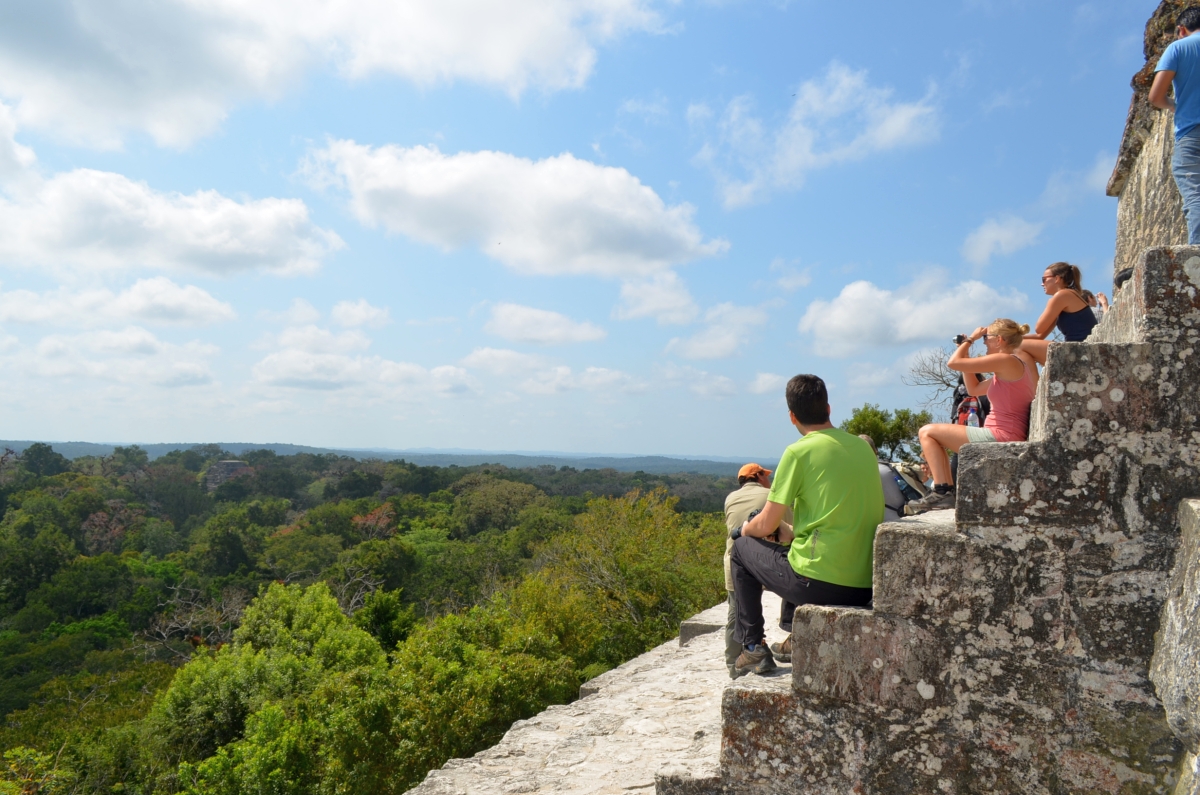
Lonely Planet recently named Singapore their number one county to visit in 2015, which in it of itself is fine, except for the fact that it’s technically a city/state, right? That’s like saying my favorite food in the world is gum. While technically correct, it’s not exactly a satisfying an answer. (Actually, I don’t really chew that much gum — I’m more of a Werther’s Original guy, but that’s besides the point).
They have some other good suggestions on the list as well, including Namibia, The Philippines and Nicaragua, all of which are worthy contenders for your next trip. However, none of them happen to be places that Contiki is highlighting on their “New Destinations” page (except for Morocco, the idea of which I’m pretty sure Lonely Planet stole from Contiki). Weird, right?
That being said, I’d like to highlight three of the countries they offer tours to, not because they made the cut for this list, but because I actually would love to go there (or return to in two of the three cases).
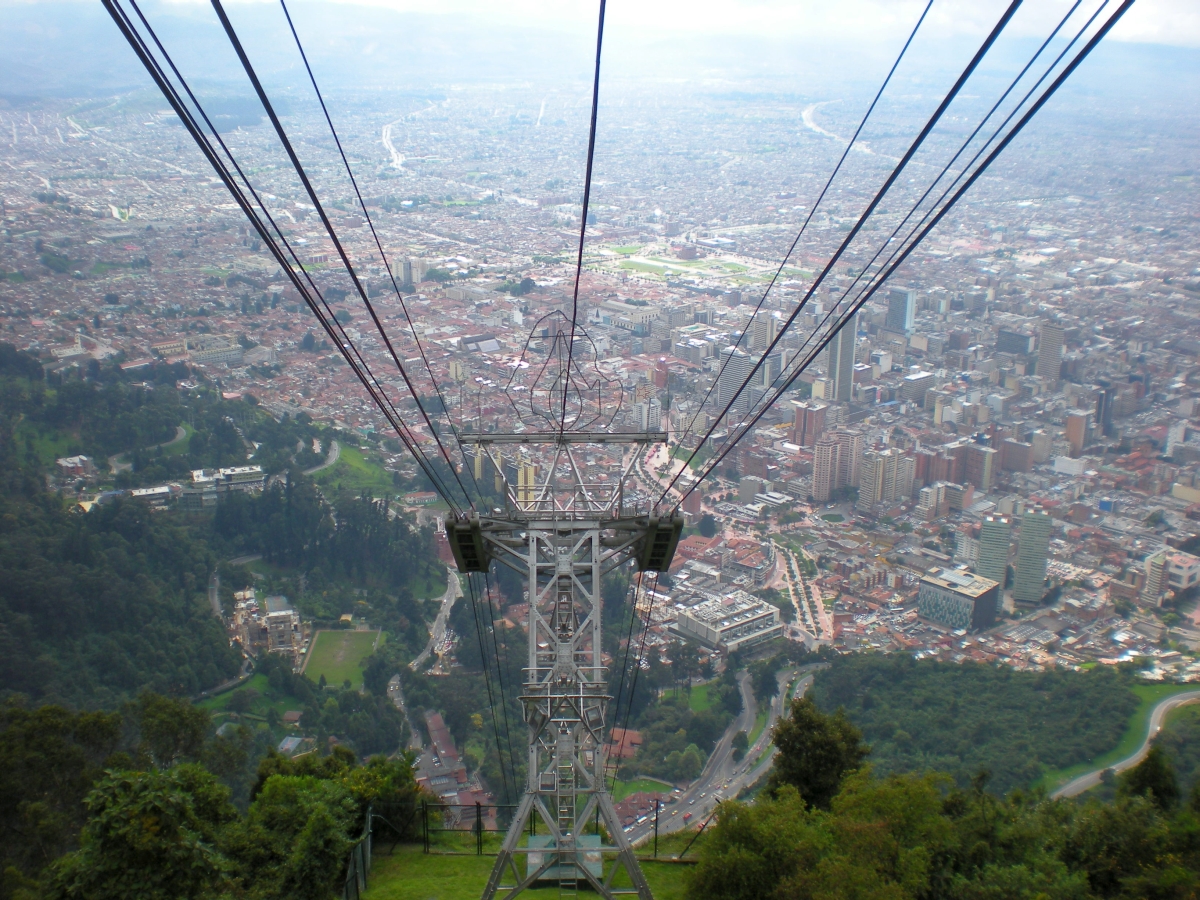
1) Colombia
What else can you say about Colombia? It’s hard to turn on the Facebook without someone mentioning how they’re grabbing the next 5-hour flight to the country to take in the splendor of a country that just a couple decades ago was persona non grata to most of the outside world.
When I was there a few years back, I made a number of videos from around the country in which I traveled to Bogota, Medellin and Cartagena, among other cities, and which I got many comments about how I wasn’t playing the correct music in the background for each particular city’s video. Oh yeah, Colombians are very particular about their music (which is a good thing in my opinion).
What do I remember most about the country though? Probably how much I loved it there, including the food, the weather, the beaches, the people and the absolute insistence too many people had back home that I shouldn’t go. Man, that felt good to go anyways.
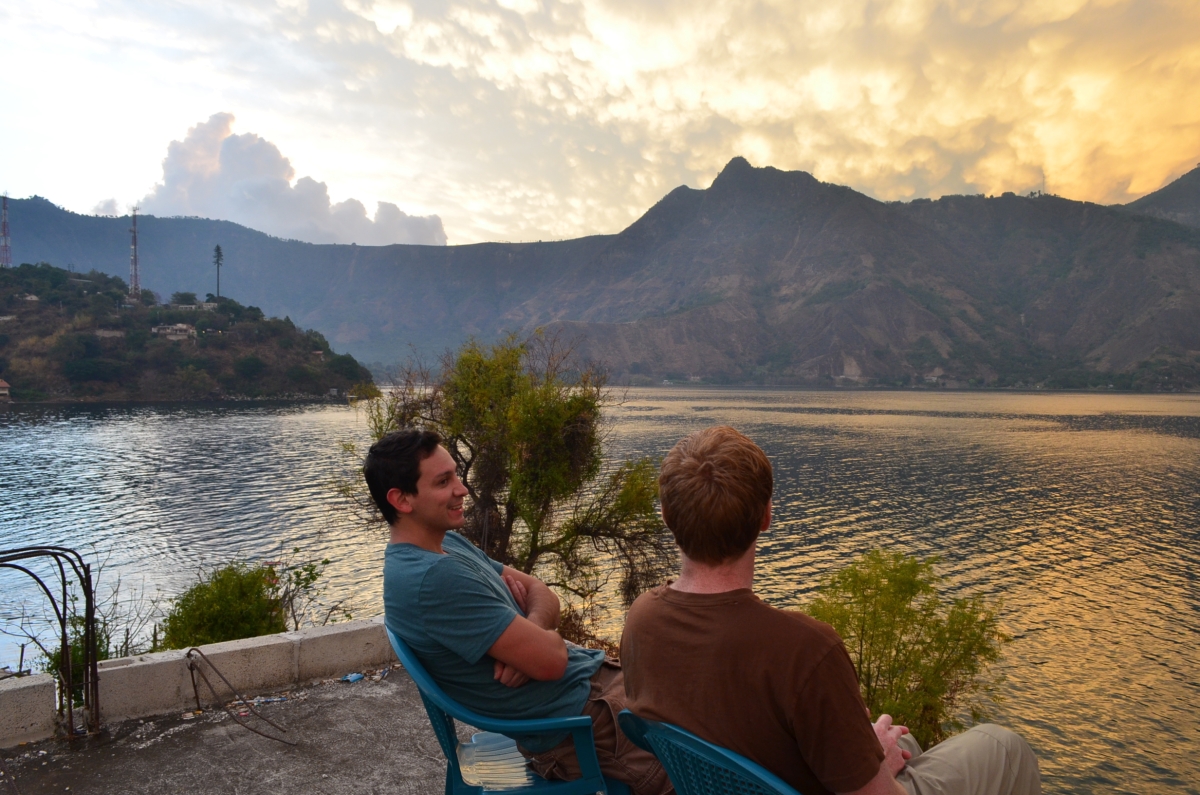
2) Guatemala
My friend and and contributor to this site, Luke Armstrong, is either from South Dakota or Guatemala, I keep forgetting which. What I do know is that when I went down there a few years ago to visit him and his group of ex-pat friends, he was certainly not treated like a Gringo at all. In fact, I think he was affectionately known as “The Man That Wears Shoes Made of Goats,” and was treated like a local.
Under his mastery of the Spanish language, including the many colorful ways to swear, we traversed the country, including stops in the always amazing Antigua, the stunning Lake Atitlan, scenic Semuc Champey and wondrous Tikal. Guatemala is usually my go-to country to suggest when people mention they want to visit Central American but don’t know where to go, and I have fond memories of visiting the county and almost getting burned alive on an active volcano (surprise, I made a travel video from there too!).
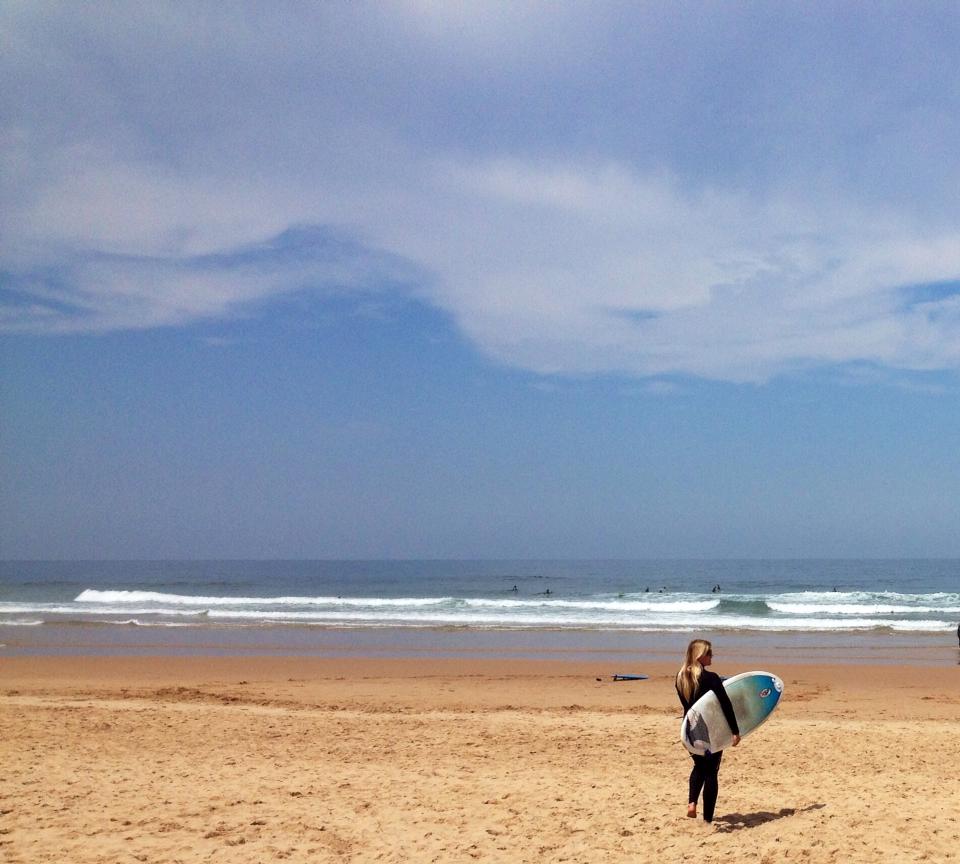
3) Portugal
I haven’t been to Portugal yet, but if there was ever a time to go there, it’s now. Why? Well, try having a conversation with anyone with absolutely any taste or insight into the pulse of “what’s cool” around the world, and I guarantee you will hear the line, “Lisbon is the place to live now,” or “Lisbon is the new Berlin.”
Something about the economic crisis a few years ago, the country’s unwavering attention to its proud culture and the fact that Portuguese sounds so good to the ear makes it perennially one of the best places in the world to travel to.
Portugal is also home to the biggest wave ever surfed (in Nazare), a video of which may be the most frightening thing I have ever seen in my life.

/
 Matt Stabile is the founder and Editor-in-Chief of TheExpeditioner.com. You can read his writings, watch his travel videos, purchase the book he co-edited or contact him via email at any time at TheExpeditioner.com.
Matt Stabile is the founder and Editor-in-Chief of TheExpeditioner.com. You can read his writings, watch his travel videos, purchase the book he co-edited or contact him via email at any time at TheExpeditioner.com.
The post 3 Countries To Visit In 2015 If You Don’t Want To Be Lame appeared first on The Expeditioner Travel Site.
]]>The post Medellin: A Tale of Two Cities appeared first on The Expeditioner Travel Site.
]]>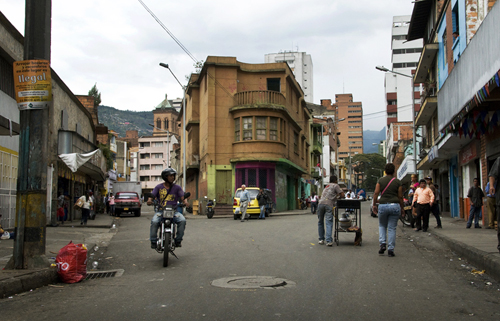
Pan-American Transmissions: Part 7
“Pan-American Transmissions” is a travel series from Special Contributor Diego Cupolo as he travels south from Nicaragua to Argentina. He has few plans, a $10-a-day budget and one flute-playing gypsy companion. Check back as new dispatches are posted from the road.
Fourteen-year-old hookers stand at the corner from Medellin’s central plaza waiting to be picked up by the next businessman on lunch break. They stay there every day in groups of three or four chewing pink bubble gum under the shade of “voluminous” Fernando Botero sculptures.
When the girls are done working, they walk home to the Zona Rosa (Red Light District) or go up into the mountains, to the brick-red tsunami of slums that surrounds the city. Their white-collared clients, on the other hand, go far south to El Poblado, the wealthy, tree-lined neighborhood full of shopping malls, fashionable bars and fashionable restaurants. The two groups tuck into bed on opposite sides of the city, but each lunch hour they meet in the center to get what they need from life: money and more exciting ways to use it.
Few regions in the world demonstrate the gap between the rich and poor more dramatically than Latin America and for those interested in exploring both sides — diving headfirst into both sides — few cities in the world display the two realms like Medellin, Colombia.
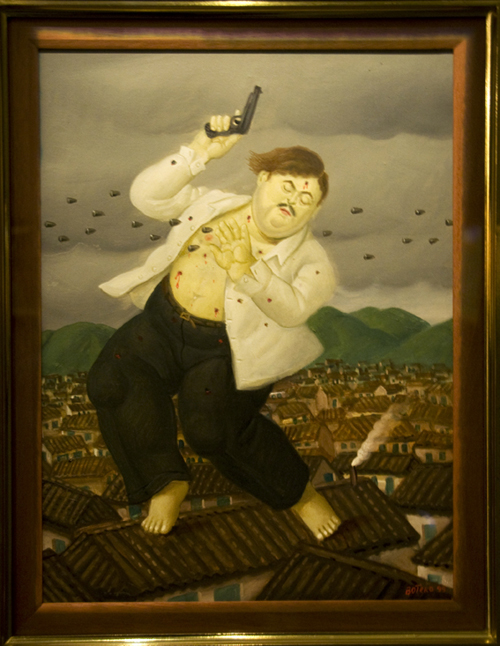
Once home to Colombia’s most notorious drug-trafficking cartel, Medellin began adopting a series of progressive policies after Pablo Escobar’s assassination in 1993. The city quickly shifted into “renaissance mode” by expanding social programs and health services, but most notably, by installing a pioneering public transportation network that connected its poorest residents to the city center.
Today, people living in mountaintop comunas (slums) can get to downtown metro lines via cable cars in less than 30 minutes. The goal was to give more residents a chance to work and study in the city center, a measure that’s being lauded throughout the continent.
What this translates to for visitors is: 1) Unprecedented access to poor areas and life outside the center, 2) Cheap cable car rides above an endless network of slums, full of unimaginable urban scenery, and 3) A taste of what Latin America is really about.
Ania and I spent a couple weeks exploring the two sides of Medellin. One week in the gritty Red Light District. The other in the posh El Poblado district. The experience left a big ball of injustice in our throats and a book full of stories in our heads. The following is a 21st century Tale of Two Cities.
Medellin One
The Afro-Caribbean whores at the front door told us not to stay there because it was “indecent”; the owner told us not to stay there because “he charged hourly rates, not daily”; and the cleaning lady, well, she didn’t really care. It took a little convincing, but with a few jokes and some shameless effort we got into Hospedaje Media Luna on Avenida Bolivar, a cheap sex hotel in the middle of the Red Light District. The room was $5 a night and it came with clean sheets, a private bathroom, a television and free mini soap bars.
It was surprisingly good.
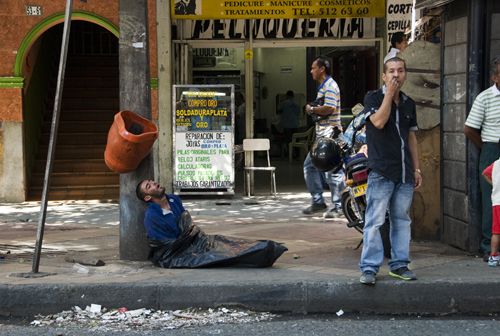
The street outside was a different story. Ania and I went to buy bread and in one block’s distance we saw about 15 tales of insanity, drug abuse and poverty: a homeless man with one leg shooting up on the pavement; an old women dragging 50 filthy plastic bags, vomiting into the sewer grate; five tranny hookers sitting in a hotel stairwell, wearing nothing but g-strings, making cat calls at the passing traffic; a crackhead walking in circles, talking out loud to no one in front of a fruit stand; little boys, none older than 11, all huffing shoe glue out of black plastic bags to get a 10-minute high; and a group of plump ladies sorting through garbage in the street, looking for old produce that can be re-bagged and re-sold at discount prices.
All this, and it was only 7 p.m., a few minutes after sunset. I stood with my back against the wall, looked up at the purple sky and figured it was best to get to the hotel before it got any later. We got the bread, walked back to Media Luna, shut the door tight and that’s where we stayed. Ania and I passed our first night in Medellin eating tuna sandwiches and watching Saturday Night Fever in Spanish.
When the sun rose again and the addicts went back to sleep we went out for a walk to the nearby Botero Plaza. It was full of fat sculptures (or as Botero calls them, “voluminous”). Somebody handed us free tickets to the Museo de Antioquia so we entered and looked at more fat people art. It was nice. Classical art with a twist, but repetitive. Regardless, Medellin-born Botero is the most famous Latin artist alive and, along with Shakira, he is the pride of Colombia.

After a few more strolls through the city center, Ania and I took a ride in the cable cars to the slums up high in the mountains. It’s hard to describe the experience. We watched a somewhat functional cityscape turn gradually into a shantytown labyrinth of terrible roads and corrugated metal rooftops. People living in rubble. Kids walking barefoot through black tar rivers, soccer ball in hand. It makes the stomach turn and the mind pound against the skull.
“What is the difference between us and the people below?” I wondered.
“Nothing. Just the place you were born,” a voice responded.
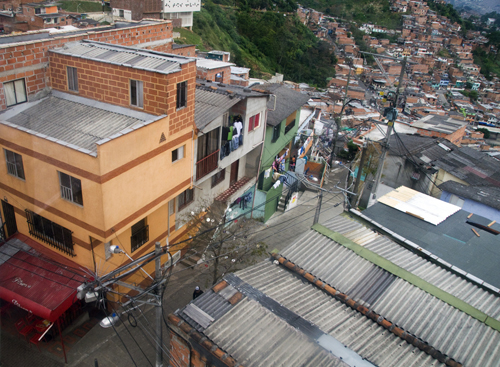
When we got to the top there was a nice, somewhat safe neighborhood to explore. The slum had been slowly evolving since the cable car line was built. There were restaurants, fruit stores and pharmacies. Transportation raises property value, sure, but in slums, any attention at all raises hope.
We found a newly built library full of local schoolchildren, all of them reading books and doing their homework. Ania and I walked around, enjoyed marvelous views of the city and left the slum feeling more optimistic about the world.
Things can get better.
Then we got back to the Red Light District. Ania and I were walking back to our hotel on Avenida Bolivar when a tranny in a bath towel ran out in front of us. Everybody on the block stopped to watch as she dashed across the street and started punching a big Afro-Caribbean mama. It was violent. The big mama was defenseless as both her hands held a big bucket of candy.
The tranny wasn’t slowing down with the punches so the big mama hit her with everything she had: the big bucket of candies. A thousand colored wrappers exploded into the air like fireworks, and the the two came out from the smoke, this time running back across the street. They were both yelling something before they disappeared back into the hotel.
Then there was silence. Just when we thought it was over, the two ran back out. This time the tranny was holding a long piece of plywood and chasing after the big mama. When they reached the middle of the street, the tranny threw the plywood at the big mama and missed. Everyone laughed, some clapped, and the show had become a spectacle. The tranny, red in the face and sweating off her makeup, ran back in the hotel at that point. To my surprise, her towel stayed on the entire time.
As for the big mama, she looked around and breathed heavily for a moment. She seemed confused, replaying everything that just happened in her mind. Eventually, she walked back to her candies — which were now spread out all over the street — and she began picking them up, one by one, as she cried.
It was hard to watch, but after a few quick inquiries we were told the big mama walked out on the tranny without paying her bill. The moral of the story: never cheat a tranny.
Medellin Two
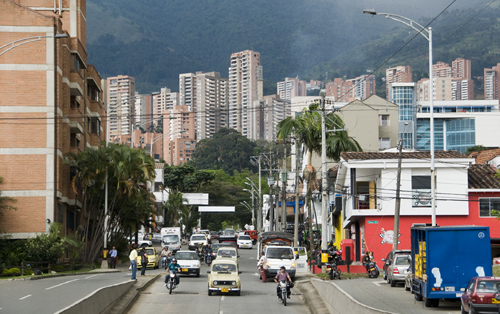
After a week of watching kids huff glue and have seizures in the street, Ania and I decided to move to El Pobaldo, a wealthy neighborhood on the other side of the city. A friend in Cartagena told us we could get free lodging at the Hostal Sunshine on Calle 9 if we worked the reception desk so we followed the tip . . .
. . . and it turned out to be true. A nice Israeli guy with long hair and big pupils owned the place. He gave us work without asking too many questions. The deal was simple: work three shifts at the reception desk and receive one free week of lodging, wi-fi, laundry service and kitchen use — not bad.
We put our bags in our new room and went out to see the neighborhood. It was the polar opposite of everything we saw in the city center. People wore designer clothes, drank Heinekens and spent their time thumbing iPhones as they walked poofy little dogs. The sky was lined with shiny white luxury apartments and the streets were lined with their shiny white electric fences. Green was everywhere. The streets had gardens and trees and nice, clean parks with swing sets and hopscotch. Organic grocery stores existed. There were bars, restaurants and little streams with benches next to them. El Poblado had it all and because of this it was home to the majority of backpackers’ hostels in Medellin.
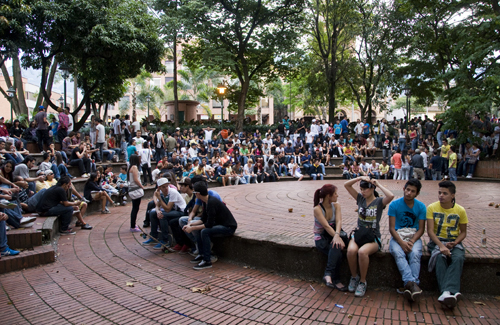
With good reason, too. The neighborhood’s known for its all-night parties and extravagant nightclubs. To put it simply: There’s a lot of blow going around. Unfortunately, Ania and I didn’t have the money, the clothes nor the appetite to get into El Poblado’s party scene. During our stay at Hostal Sunshine we kept living between the two sides of the city (or better said: the two sides of Latin America).
We’d buy cheap groceries from desperate street vendors in the Red Light District and then help manicured tourists call taxis in El Poblado. It took some time and patience to adjust in our new roles as hostel receptionists, but, then again, most of the job involved doing nothing. We cleaned a few things and made sure the bathrooms had toilet paper. Everything was great. Everything was easy.
Until the weekend.
I was assigned night shift on Friday and Saturday. This meant sleeping by the front door to let in the drunks as they stumbled home. I slept on a couch and when someone buzzed, I’d get up, let them in, and watch them walk to the back room with a bottle of aguardiente to keep partying and snorting lines till the next afternoon. How they yelled.
I wanted to sleep, but couldn’t. It was unpleasant, to say the least.
The second night was the same only there was a car robbery in front of the hostel at 3 a.m. A girl was pulled out of her Chevy at gunpoint and the thieves hopped in and drove away. I woke up to the sound of the screeching tires zipping by the front door. When I opened the door, I found the girl crying on the sidewalk so I let her into the hostel to calm down, call the police and shiver for a while as she waited.
By pure luck, the cops tracked down the car in the city center and returned it unscratched. The thieves went to jail.
In the morning, all hostel guests were shocked by the car robbery. These things weren’t supposed to happen in El Poblado, but they did and to rub it in, the next night there was another robbery in front of the hostel. This time it was a purse.

I barely got to sleep that weekend and in my zombie daze I thought over the circumstances in Medellin.
It’s plain and obvious: Even if El Poblado is the city’s safest neighborhood, there’s a mass of people living in deep, wretched misery on the other side of the green parks, the jogging tracks, and the rooftop swimming pools. It doesn’t matter how high the electric fences are built, misery breeds crime that seeps through all barriers.
The scenes Ania and I saw in Medellin happen in all urban areas throughout Latin America and, most likely, throughout the rest of the developing world. It’s not just a few people living in a few slums either, it’s the majority of the world’s population that suffers these unnecessary conditions on a daily basis.
Medellin illustrates a severe tale of inequality, but with its progressive social programs, its mountaintop libraries and its all-inclusive transit system, the city’s also setting an example for the rest of the world: inequality lowers everyone’s living standards, no matter which side of the city we live on. The only way to make improvements is by making sure they reach all parts of a city and benefit all levels of society.
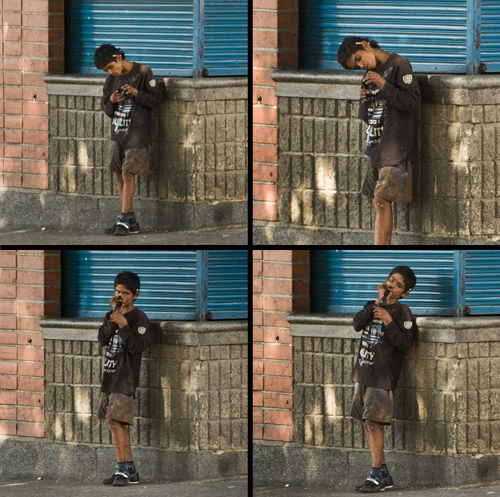
By Diego Cupolo
Coming up next from Pan-American Transmissions: Into the Andes: The High Road Through Ecuador. Read all of the other Pan-American Transmissions entries here.

About the Author
 Diego Cupolo is a freelance photojournalist currently on the road to Tierra del Fuego. Most recently he served as Associate Editor for BushwickBK.com, an online newspaper in Brooklyn, and his work has appeared in The New Yorker, The Atlantic, The Star-Ledger, The Australian Times, Discover Magazine and many other publications. View more of his work at DiegoCupolo.com.
Diego Cupolo is a freelance photojournalist currently on the road to Tierra del Fuego. Most recently he served as Associate Editor for BushwickBK.com, an online newspaper in Brooklyn, and his work has appeared in The New Yorker, The Atlantic, The Star-Ledger, The Australian Times, Discover Magazine and many other publications. View more of his work at DiegoCupolo.com.
The post Medellin: A Tale of Two Cities appeared first on The Expeditioner Travel Site.
]]>The post Pan-American Transmissions Part 6: Capurgana, Taganga and Colombia’s Sweet Caribbean Cacophony appeared first on The Expeditioner Travel Site.
]]>
Pan-American Transmissions Part 6
“Pan-American Transmissions” is a travel series from Special Contributor Diego Cupolo as he travels south from Nicaragua to Argentina. He has few plans, a $10-a-day budget and one flute-playing gypsy companion. Check back as new dispatches are posted from the road.
The FARC is almost dead, and it’s dinosaurs that seem to be alive and roaming through the jungles near Capurgana, Colombia. At least that’s what it looks like from the dock. Ania and I stared in disbelief as our boat pulled into the harbor of the small Afro-Caribbean village.
“Places like this really exist?” Ania asked.
It was hard to take it all in after the long, stale journey through Panama’s Kuna Yala islands. Massive waves exploded into white foam on black stone cliffs, hordes of pelicans squabbled over jagged rock islands and monkeys screamed from the canopies overhead as we disembarked.
“We made it,” I responded.
Pure, wild, tropical paradise without a car in sight — Capurgana is on Colombia’s mainland, but it’s only reachable by plane or boat, making it feel more like a lost island in the Caribbean than a part of any country. Located just south of the Panamanian border, we expected the worst from immigration officers, but they let us pass without checking our bags so we bought a couple fresh mangoes and headed straight to the beach.
It was there, on that fine warm sand, that I realized something about Colombia. Sure, there were rifle-touting 17-year-olds in camouflage patrolling the town’s perimeters, but the place was offensively beautiful. Incomparable to anything in Costa Rica.
With natural gems like Capurgana and Taganga, I wondered what Colombia will become when its internal conflicts are finally resolved. (Which might happen sooner than anyone expects.) Colombia could be — and some say it’s already becoming — a major travel destination and international economic power. The question is: How long will it take?
As Ania and I would soon find out, the Caribbean coast is a good place to start observing the progress for anyone that’s not willing to wait.
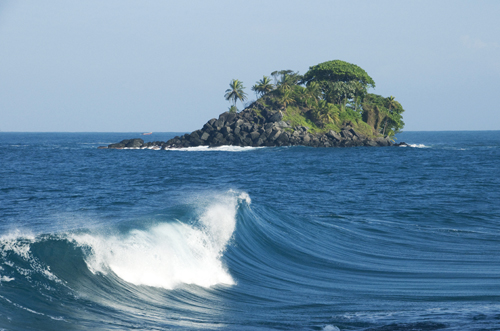
Capurgana: Donkey Carts and Reggae Music
Those resilient enough to get there will be heavily rewarded. Capurgana is gold. A refuge from the rest of the world surrounded by humid green, red mud jungles and pristine cyan waters.
Best of all: Capurgana’s incredibly cheap for everything that it offers. Ania and I found a place to camp for $1.50 a night each. We set up our tent across the street from the sea and went for a walk around town.
The first thing we noticed were the donkey carts — automobiles are useless in a place where all roads end in the jungle. The second thing we noticed was the town center: a soccer field lined with bars, each one playing reggae music as loud as possible 24 hours a day. The competing sound systems made a mix of incomprehensible noise so Ania and I headed towards the more peaceful rhythms of the waterfront.
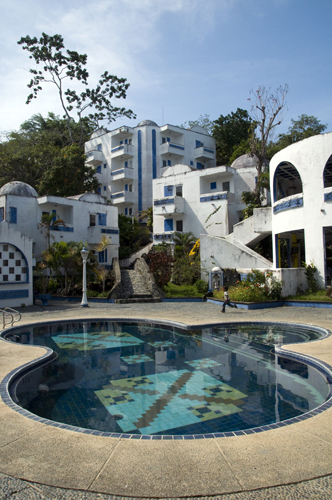 There we found a myriad of trails. Some went through the jungle; others snaked over the rock cliffs by the sea. Both were covered with tiny green and black poison dart frogs. We passed an abandoned mafia palace of a hotel on the way and followed a trail along the sea to a luxurious, natural tide pool. Waves crashed on the rock walls and replenished the fairly large tub of hermit crabs and sea foam as we sat in warm water, wishing we had brought champagne.
There we found a myriad of trails. Some went through the jungle; others snaked over the rock cliffs by the sea. Both were covered with tiny green and black poison dart frogs. We passed an abandoned mafia palace of a hotel on the way and followed a trail along the sea to a luxurious, natural tide pool. Waves crashed on the rock walls and replenished the fairly large tub of hermit crabs and sea foam as we sat in warm water, wishing we had brought champagne.
When we got our fill, Ania and I followed on the same trail further into the jungle until we reached the home of a lone rasta artist. He asked for donations to enter his garden, but it seemed like a tourist scam so we turned around and returned to our tent.
The next day we joined a group of travelers and followed a trail through the jungle, over an extraordinarily humid mountain and ended up in the neighboring seaside village of Sapzurro — a smaller version Capurgana. It was nice and stunning and all, but locals said the nicest beaches were a little further, just across the Panamanian border in a place called La Miel, so we kept on marching.
The hike was worth it. La Miel has some of the highest ranked white sand beaches in the entire Caribbean. Some places have a trash problem, but we got away from the main beach, found our spot among flower bushes and cracked open coconuts the rest of the afternoon as our friends practiced their juggling.
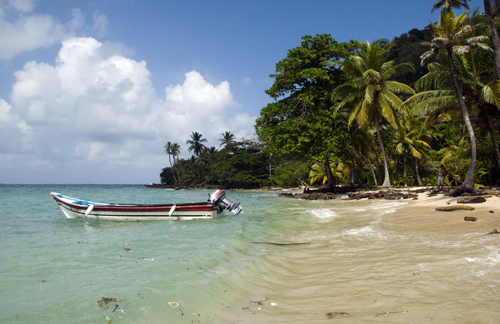
I could’ve easily stayed there for the rest of my life — in La Miel, in Sapzurro, in the sweet raw smell of everything around Capurgana — but the voyage had to go on. Too much beauty can deteriorate the mind.
Taganga: Choose your Beach, Choose your Fish
Ania and I rode a speed boat like a skipping stone to a port on the mainland called Turbo. From there we hitchhiked all the way to Cartagena with a Swiss couple that wouldn’t admit to being a couple and our old Argentine friend, Felix. The process took a few days and involved riding in a brand new Renault sedan latched on the back of an 18-wheeler along with seven other cars bound for a city dealership. (How else could five people catch a ride together?)
Cartagena was fine, and it’s good for drinking and partying — just stay in the city center! — but Ania and I got bored and continued east to Taganga, a fishing village turned hippie/backpacker mecca.

After Capurgana we thought we had seen everything Caribbean Colombia had to offer, but Taganga was beautiful in a completely different way. It was much drier. Cactus stubs dotted sandy coastal mountains that dropped straight into the sea. The rugged terrain formed countless tiny beaches, accessible by boat or hiking, and the choice of where to lay our towel was about the only thinking we did during our stay.
By that point we had thoroughly marinated in the Caribbean culture. Once you absorb it, it’s hard to get away.
Many travelers visit Taganga because it’s the cheapest place in the world to get scuba diving certification. Good to know, but Taganga’s also next door to some of Colombia’s main attractions, Tayrona National Park, and the mysterious Ciudad Perdida, the ruins of an ancient city hidden deep in the park’s jungle.
Regretfully, Ania and I didn’t go to either of these places because it was high season and the entry fees were doubled. What we did do was hike around the desert mountains until we got too hot and then went swimming. The scenery in Taganga was enough for us. It didn’t feel like we were missing much. To top it off, at the end of each day, we’d stop by the fishing boats and pick out fresh barracuda to grill for dinner.
Life was simple and life was delicious. On the edge of town, we found a hostel that charged $1.75 a night for pitching a tent and slipped into yet another crowd of ragtag Argentinians that sang all night and drank all day.

The only problems in Taganga are directly linked to the heavy tourism. The infrastructure can’t handle many people and the water runs out sometimes. (I brushed my teeth with purple water leftover from boiling beets for a few days.)
Taganga’s also known for its never-ending supply of hard drugs. It’s easy to get lost in it, but also easy to avoid it — your choice. I didn’t think much of the scene until I found a bag of coke on the ground. I picked it up and offered it to a girl selling arroz con leche in the street and she gladly accepted. To my surprise, she wouldn’t give me a free cup after the gift.
Ania and I roamed around Taganga for a few more days, then we finally gathered up enough mental strength to pull ourselves from the lazy Caribbean shores and explore the rest of the country.
It was necessary. We were losing track of time.
We hit the road again and caught rides form town to town. Hitchhiking in Colombia turned out to be much more challenging than in other countries, but somewhere en route to Medellin, a young engineer gave us a nice lift. He was educated and informed so we talked for a few hours about Colombian politics, the FARC and narcotrafficking. He said he was glad to see more tourists in the country.
“Too many people focus on the negative side of Colombia, but you’ve seen how beautiful our land is, you know we’re not all selling cocaine. There’s a small number of bad people giving the rest of us a bad global image,” he said.
In the end, he said he was confident things would change for the better.
“Colombia’s moment is coming,” he said. “The FARC is getting weaker every month. They have no direction. They’re just a bunch of young kids that are running out of ideas and, pretty soon, we’ll be running them out of this country.”
To this day, I still think about the possibilities . . .

By Diego Cupolo
Coming up next from Pan-American Transmissions: Medellin: A Tale of Two Cities.

About the Author
 Diego Cupolo is a freelance photojournalist currently on the road to Tierra del Fuego. Most recently he served as Associate Editor for BushwickBK.com, an online newspaper in Brooklyn, and his work has appeared in The New Yorker, The Atlantic, The Star-Ledger, The Australian Times, Discover Magazine and many other publications. View more of his work at DiegoCupolo.com.
Diego Cupolo is a freelance photojournalist currently on the road to Tierra del Fuego. Most recently he served as Associate Editor for BushwickBK.com, an online newspaper in Brooklyn, and his work has appeared in The New Yorker, The Atlantic, The Star-Ledger, The Australian Times, Discover Magazine and many other publications. View more of his work at DiegoCupolo.com.
The post Pan-American Transmissions Part 6: Capurgana, Taganga and Colombia’s Sweet Caribbean Cacophony appeared first on The Expeditioner Travel Site.
]]>The post My Salsa Lessons From A Prostitute In Colombia appeared first on The Expeditioner Travel Site.
]]>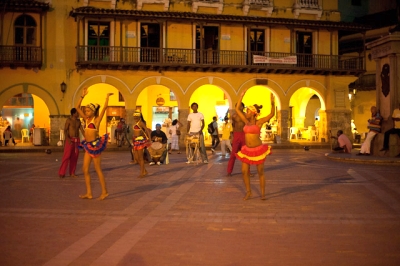
“Dude, if you wanna meet local girls you gotta be able to dance.”
I avoided the tango in Buenos Aires, but it’s going to be hard to avoid salsa in the Caribbean.
“I hate dancing.”
“You’ve just gotta move your hips.”
“I’ll need a few more of these first.”
I take another sip of watery beer. Colombian beer isn’t great but at least it’s cold. It’s still as hot as hell even though the sun went down two hours earlier. The humidity is unbearable.
Me and Mo are sitting in a small square in front of the church of Santisima Trinidad in Cartagena’s working class neighborhood Getsemani. A Major League Baseball game is projected on the church wall. A local armed with a microphone provides Spanish commentary and the sound reverberates off the surrounding homes. Caribbean music is being played somewhere.
There’s a community atmosphere in the square. Families are lining the bench seats eating food served by street vendors. Kids are playing soccer. A couple, limbs intertwined, are staring into each others’ eyes. There’s an important game of chess playing out next to us.
A street dogs lies at Mo’s feet. He tries to feed her but she’s not hungry.
“Let’s go,” he says.
Looking around I start to feel a little envious. Maybe it’s the six months of mostly solo travel, but at this moment I want to be a part of their community. I want to sit and talk about work, the weather, or what my crazy neighbor Carlos is up to.
I could stay here all night but Mo is determined to see me dance.
With new Aguilas we stroll through the narrow backstreets, Mo’s new friend following us for a few blocks. Families are sitting out the front of their homes on plastic chairs, avoiding the heat trapped inside.
The colonial Spanish architecture is beautiful, but in this area the yellow paint is fading and peeling on every building.
We arrive at the central tourist area called El Centro. The architecture is the same as Getsemani but the paint jobs are fresh. It’s clean and there’s well dressed tourists everywhere. I can’t see any drug dealers.
El Centro, also known as Old Town, is surrounded by a 20-meter-thick wall lined with rusty cannons aimed at the Caribbean Sea. It was built by the Spanish in the 16th century to protect the city from pirates. But the city will have no defence for assault I’m about to launch on the dance floor.
We walk across Plaza de Los Coches for the first nightclub we see.
“Here, wear my hat.”
I put the black pinstripe fedora on and laugh. I feel like an idiot.
“The girls will love it.”
“I need rum.”
We cross the cobblestone street, pass the bouncers and go into the converted nightclub.
We follow the music to the second floor and open the doors. It’s dark and almost empty. We order Cuba Libres and case the joint like two ex-cons.
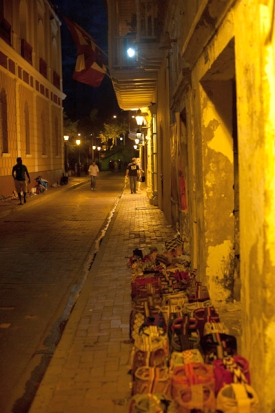 There’s a long single room with a balcony at the far end overlooking the plaza. In the center is the dreaded dance floor, with tacky red lighting and a disco ball. It’s occupied by about 20 drunk backpackers, there are no locals and there is no salsa dancing. I relax a little.
There’s a long single room with a balcony at the far end overlooking the plaza. In the center is the dreaded dance floor, with tacky red lighting and a disco ball. It’s occupied by about 20 drunk backpackers, there are no locals and there is no salsa dancing. I relax a little.
Closer to the bar is a dark lounge area with furniture that look more like props from a bad science fiction movie. Two Colombian girls are talking to an overweight, effeminate looking Colombian male. I know what Mo’s thinking.
“Lets talk to the girls.”
We walk over and pull a up a space cube. Their male friend leaves. The girls are very beautiful; they have dark skin and long black hair. They could easily be models. They look bored but smile when we sit down. I immediately recognize they’re prostitutes.
It’s made clear early on, through Mo’s basic Spanish, that we’re not interested in their “professional services,” but they’re happy to talk since business is obviously slow. I sit next to Maria and feel a little intimidated.
Maria’s from nearby Barranquilla and she is built like a ballerina. She has a friendly face and a beautiful smile. Her English is a little better than my Spanish, which isn’t saying much, and I purposely avoid talking about occupations. What were we supposed to talk about?
Thinking about what to avoid I mention salsa and her eyes light up. Colombians love to dance, especially salsa. When I tell her I can’t dance she grabs my hand and pulls me to the dance floor.
She takes my hands and urges me to follow her steps. The music’s slow and the steps aren’t too hard. I watch her hips. They move with a fluidity and grace that is mesmerizing. I try to copy her but it’s not pretty. I feel like a garden hose out of control. Maria doesn’t mind, she’s happy to be dancing and keeps encouraging me.
The music speeds up and the dancing starts to heat up. She is twirling, writhing down to the floor and back up, and pulling me close, all without missing a beat. Her timing is impeccable.
After a few more songs I’m still doing the same basic steps but I have no idea what Maria’s doing. She’s really getting into it now, I don’t even know if it’s salsa anymore. It’s damn sexy though and I’m not going anywhere.
Mo is clapping and laughing and gets on the dance floor with his new friend — he’s a natural. We’re having fun dancing in the heat and sweat of our first Caribbean nightclub. We keep going for a few more songs and eventually, worn out, we return to the space lounge for a break. We chat with the girls for a while and this time it’s more relaxed and open. Maria tells me she came to Cartagena to pursue a modeling career. I hope she keeps trying.
The night comes to an end and we buy the girls a drink and say good night. I thank Maria for the salsa lessons and we go outside. I’m reluctant to admit to Mo that I had a good time dancing, but I’m already secretly looking forward to trying salsa again.
By Matt Dawson
[All photos by the author]

About the Author
 Matt Dawson is a freelance writer and photographer from Australia. He loves exploring new destinations and learning from different cultures, and is equally at home sipping rum in the Caribbean or snowboarding in the Rocky Mountains. Matt has spent most of 2011 embarrassing himself with poor Spanish throughout South America. He is currently residing in London. Check out more of Matt’s work on his website.
Matt Dawson is a freelance writer and photographer from Australia. He loves exploring new destinations and learning from different cultures, and is equally at home sipping rum in the Caribbean or snowboarding in the Rocky Mountains. Matt has spent most of 2011 embarrassing himself with poor Spanish throughout South America. He is currently residing in London. Check out more of Matt’s work on his website.
The post My Salsa Lessons From A Prostitute In Colombia appeared first on The Expeditioner Travel Site.
]]>The post Ideas For Travel To South America This Fall appeared first on The Expeditioner Travel Site.
]]>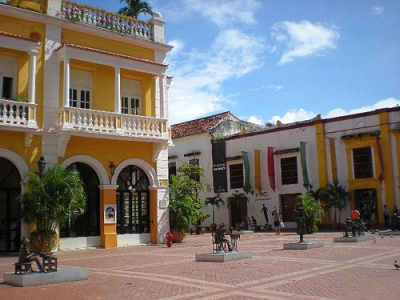
Is there nothing better than shipping off on a red-eye flight in the depth of a cold winter night and arrive, half-a-day later far on the other side of the Equator (assuming you’re coming from the north) in warm South America? Plants are budding, locals are excited about the onset of summer, and you’re just glad to spend a week or two far from any vestiges of black snow banks and flu-infested workplaces.
With that in mind, Condé Naste Traveller (or what I like to sometimes call Condé Nasty if they let me) decided to ask South American travel expert Sue Lyall about where to go, what’s hot, and where to stay in the continent. Here are the highlights.
Hottest Country: Argentina, for its hiking, good eats, llamas and wide variety of activities in this large swath of land. You had me at llama.
City to Visit: Cartagena, because of its historic old city, its nightlife and its beaches. And also because people, despite everything that’s been written about the country, don’t realize how amazing Colombia is, so it’s not totally overrun by tourists yet. It will also make you realize how completely unaesthetic your neighborhood is back home.
Best Place to Stay: Pousada do Toque hotel in Alagoas in Brazil, because it’s located on the ocean just north of Bahia, there are manatees there (enough said!) and the area is still pretty unknown, thus once again, not too many tourists.
The post Ideas For Travel To South America This Fall appeared first on The Expeditioner Travel Site.
]]>The post Passing Up Paradise In Colombia appeared first on The Expeditioner Travel Site.
]]>
When they felt there was enough fish to justify pulling the nets in, someone would ring a bell hanging from a palm and close to 50 men, woman and children would rush to the ropes to pull the nets in as quickly as our strained arms could muster. Teeth clenched, veins popped, and grunts narrated the fight as we played tug-a-war against the sea.
Everyone yelled for everyone else to pull harder while our hands tried to grasp onto the slippery rope. Slowness meant more fish would escape to the open ocean, which to a fishing village like this would mean less of everything for everyone.
I was northwest of Taganga, Colombia, and was spending my days with fishermen, women and children. My first day staying there in an Israeli-filled hostel, I bought fish from Luis as he sold them on the beach. I asked him some casual questions about where the fish had come from and how it was caught. After a while I invited him to a beer and he then invited me to fish with his family a short jaunt from Taganga.
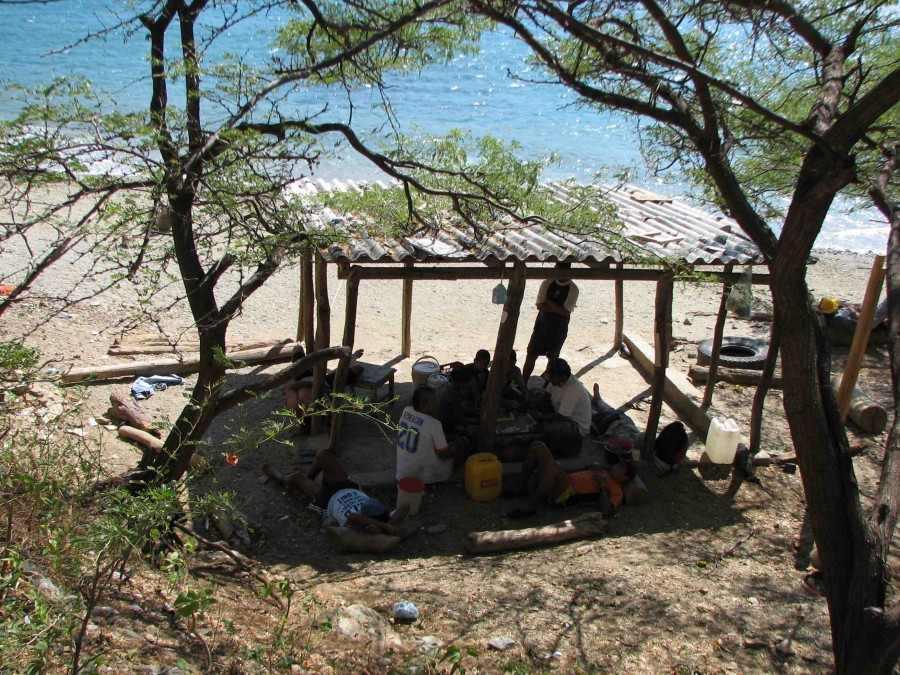 They caught fish the Caribbean way: they waited. Nets squared off two corners of pastel-colored water out from the shore. The nets were positioned early in the morning using canoes hollowed out from palms. Once the nets were positioned there was nothing to do but to sit and wait. For hour-long stretches the Colombians and I sat underneath the lazy shade of palms. A communal guitar passed from hand to hand.
They caught fish the Caribbean way: they waited. Nets squared off two corners of pastel-colored water out from the shore. The nets were positioned early in the morning using canoes hollowed out from palms. Once the nets were positioned there was nothing to do but to sit and wait. For hour-long stretches the Colombians and I sat underneath the lazy shade of palms. A communal guitar passed from hand to hand.
Luis was the unofficial leader of the group. While everyone else lounged lazily on the beach, he tended to pace barefoot on the sun-warmed sands. He looked out at the sea as one would look at an alienated lover — as if he knew her intimately but was frustrated that there was some deeper mystery he could not access.
“Drink up,” Luis would command everyone, “we need to make room in the cooler for all the fish we will catch.” Every hour someone needed to snorkel behind the nets to see if there was enough fish to make it worthwhile to pull the nets in. I always volunteered. Someone was always sent with me — they did not fully trust that I knew how to properly count the fish. It was a good call on their part; I didn’t have a clue what constituted enough fish.
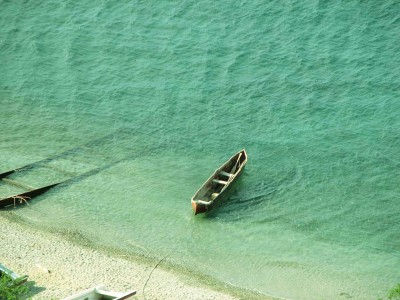 When I asked Luis the name of his village, he frowned and told me that this was not really a village. It was just four families living together and fishing, living in huts off the beach.
When I asked Luis the name of his village, he frowned and told me that this was not really a village. It was just four families living together and fishing, living in huts off the beach.
My days soon fell into a paradisiacal routine. With the rising sun I would go for a quick swim before hiking over the hills that overlooked the tourist beaches to the secluded fishing village that was not actually a village — just four families fishing. For my help, I was given a portion of the catch. This was always more than enough to feed me for a day. It’s possible that the fish I was being provided with might have been more charity than worker’s wage — something to keep the token gringo around.
There´s something about the sea. Something about the way its salt-scented breezes cause us to pause and stand staring out at the largest thing on the planet. For me, the sea was a vacation from another office life that I could have been leading. To the people I was with, the sea was their office.
I had stumbled into paradise. Or at least, a common representation of it. Beaches and palm trees mess with our minds. Most travelers, or at least lucky ones finding their trip just short of perfection, toy with the idea of never going home. Turning what was only ever meant to be a temporary escape from life into a life.
Fishing in paradise, I did the math. Living like I was living now, my moderate travel budget would stretch for years instead of months. Being surrounded by pristine beaches, bordered by rhythmic waves and the peace of mind of schedule-free days, pushed me further into wanting to cast my future plans into the Caribbean and stay.
If it was not for the annoying and inevitable longing for loved ones and their affectionate familiarity, then we could move through the world freely. I could do it, I thought, I could leave the world behind and stay here. This thought was accompanied by the simultaneous realization that I would not actually do it. It was the very fact that this would all soon end that was giving the thought of staying a wistful value. At some point we all long for home. Home not as a place, but as a state of affairs where we can find familiar comforts and the intersecting lives of loved ones.
Everyone with a lot of time logged on the road has run into those travelers who went further than the mere contemplation of not going home. Travelers who turned month-long trips into lifetimes. I’m not talking about ex-pats who made their homes somewhere abroad, but the people who spend years and decades on the road, never remaining in one place long enough to call it home. Home is wherever my feet are planted, their mantra rings out on distant beaches and in far-flung bars.
 The younger ones always seem free, passionately living out idyllic dreams. But sometimes it is hard to tell the difference between an ideal and the ghost of an ideal. The travelers who have been on the road for so long that they no longer have homes to return to always seem lost. Lost not on the map, but in years stacked on top of years away from a home. They have stayed loyal to their youthful ideals, but when the party ends and everyone goes home they are left to wander dark streets flanked by windows where no one has left a light on for them.
The younger ones always seem free, passionately living out idyllic dreams. But sometimes it is hard to tell the difference between an ideal and the ghost of an ideal. The travelers who have been on the road for so long that they no longer have homes to return to always seem lost. Lost not on the map, but in years stacked on top of years away from a home. They have stayed loyal to their youthful ideals, but when the party ends and everyone goes home they are left to wander dark streets flanked by windows where no one has left a light on for them.
On my last day fishing, I looked regretfully out to the waves and listened to their rhythmic crashing. The winds carried a seafood scent that caused me to breathe in as deeply as I could. The midday sun bathed me in its warmth. I soaked it up, saving it for dimmer days. The palm trees shuffled with the wind in a playful dance. Perhaps Luis felt humility as he looked longingly out towards the sea. Out towards the massive cradle that sparked life on Earth. Out towards something commensurate to his ability to dream.
It was hard to leave, but it was time to leave. When I settled the bill at the front desk, I watched as a new set of backpackers walked through the front door to replace the departing.

About the Author
 Luke Maguire Armstrong lives in Guatemala directing the humanitarian aid organization, Nuestros Ahijados. His book of poetry, iPoems for the Dolphins to Click Home About (available for sale on Amazon.com) is especially enjoyed by people who “don’t read poetry.” (Follow Luke on Twitter: @lukespartacus)
Luke Maguire Armstrong lives in Guatemala directing the humanitarian aid organization, Nuestros Ahijados. His book of poetry, iPoems for the Dolphins to Click Home About (available for sale on Amazon.com) is especially enjoyed by people who “don’t read poetry.” (Follow Luke on Twitter: @lukespartacus)
The post Passing Up Paradise In Colombia appeared first on The Expeditioner Travel Site.
]]>The post Top 7 Places To Eat In Bogotá appeared first on The Expeditioner Travel Site.
]]>
A destination for backpackers and hip travelers, Colombia is known for its vibrant culture and friendly residents. With Medellín attracting those seeking nightly salsa partners, and Cartagena drawing travelers looking for a Caribbean beach getaway, Colombia continues to fascinate travelers and overcome its sordid reputation.
Despite its image to some, one reputation that’s well deserved for this country of 46 million is its food. Enter Bogotá, the country’s capital city, teeming with food trucks serving fresh fruit on the streets, hole-in-the-wall panaderias, sprawling farmers’ markets, and gourmet zones attracting loyal clientele. For foodies eager to taste some of the country’s best food, Bogotá is where it’s at.
To find the best and cheapest food Bogotá has to offer, travel along La Septima, the city’s major snake-like avenue that runs east to west. On weekends, locals flock to Zona G and Zona T meeting grounds to start off their nights filled with drinks, music and bar fun. On Sundays, Bogotános come out to play during Ciclovia when La Septima — one of the city’s main thoroughfares — closes down to cars and opens up to pedestrians, joggers and cyclists. During the week, students and businessmen alike hit nearby barrios for hearty meals at corner restaurants.
No matter what time of day you find yourself roaming around the city’s streets, there is much to intrigue your palette. To get you started, here are seven places to eat like a Bogotáno.
 1) Mona’s
1) Mona’s
It’s my first full day in Bogotá and I’m determined to do some exploring, so Jeff from CareerBreakSecrets.com — a fellow travel blogger I’m staying with — and I flag down a taxi and head to the city center to see where Bogotá comes alive. Surrounding us is orderly chaos: Food carts, merchants shouting out specials, knickknacks being sold for pennies (or super cheap pesos), students out with friends passing along art murals and crumbling graffiti walls, and businessmen loudly chattering over the phone on their way to lunch.
We’re ready to eat, and lucky for us we see that Mona’s is fairly empty. As I sit and look around the restaurant, I notice the plates are huge, and I question whether my appetite can handle the portions. Undeterred, Jeff suggests a typical Bogotáno dish: Pollo y carne a la plancha — a heaping meat platter paired with roasted baby potatoes, patacones (flattened fried plantains), and everyone’s favorite, arepas.
“This is lunch?” I ask the waiter.
That was just the beginning he tells me. “Una picada.”
2) Pan Fino
One of the things I love to do while traveling is to wake up early with the city. Bogotá has its own morning routines, as small bakeshops and cafes cater to commuters starting their day around 8 a.m. Lucky for me, I found a few neighborhood spots nearby to get my morning fix: Cafe con leche and a pastry — usually a croissant filled with local cheese. Bogotános tent to order coffee as tinto (a small cup of coffee) or espresso, but I choose to take things easy. Here at Pan Fino, coffee is served in a small styrofoam cup and runs only 1,200 Colombian pesos (about 75 cents). It becomes a must every morning as I head out for the day.
 3) Brot Cafe
3) Brot Cafe
In many parts of the world brunch is a cherished weekend tradition, and in Bogotá it’s no different. The same weekend I arrived, the Sunday paper ran an article called, “The Top 5 Places to Brunch in the City” — what perfect timing. So I skimmed through for the nearest recommendation, and Brot Cafe stood out for its chocolate baguette.
I head out to see if it lives up to the hype. Located on a posh street in Zona Rosa, Brot Cafe is an intimately casual, Parisian-like cafe with wonderfully simple breakfast options. I order the huevos rancheros — a dish I grew to love over my trip — which includes soft scrambled eggs with ham and cheese served in its own skillet and topped with two sausage links cooked in a rich red salsa. Cafe con leche follows, as I’ve learned drinks are often not served first before your meal. All this and the total comes out to only 7,000 Colombian pesos (USD$3.50).
4) L’Arca
Like many other metropolises, Bogotá is a city populated by regional migrants, which helps explain what makes it such a distinct food city. Its large community of expats consists mostly of those from other Latin American countries, which can be best seen when roaming the blocks near La Septima.
With this in mind, I decide to give Bogotá’s international influence a try and head to L’Arca, a cevicheria, for dinner with friends. A seafood restaurant, it was highly recommended for its ceviche and coconut rice, though my shellfish allergy steered me to the tilapia entree instead. My choice paid off, as the filet was perfectly cooked — softly seared — and the coconut rice, a first for me, was light and fluffy, and its tropical flavors were subtly infused in the grains. The meal was a fresh change from the heavier meals I was growing accustomed to here in the city.
5) Casa 53*76
Evenings come quick in Bogotá, and when it does, the city starts to slow down. It’s hard not to join in the silence of the night, but there are some cozy spots that make for great nightcaps, such is the case with Casa 53*76, an eclectic music cafe where vinyl records decorate the walls and students sip lattes gathered around small tables outside. The cafe is manned by a lone barista who tends to the smokers and coffee sippers as he mazes in and out of the cafe patio. A magazine and small coffee is all I need to relax and take in the scenery.
 6) Habra Camilona
6) Habra Camilona
Bogotános are known to escape the city and retreat to their fincas (country homes) on the weekends. In my effort to live like a Bogotáno, I joined some friends for a day trip outside of the city to explore the country’s colonial past, and head to Zipaquirá and its main attraction, an underground cathedral created in a former salt mine.
Zipaquirá welcomes travelers with guided tours, photo-ops and a charming square. Inside Fundacion Casa del Chorro, a hotel located near Plaza de la Independencia, is Habra Camilona, an inviting restaurant that serves plates of traditional homemade regional dishes at popular prices. Lunch specials run the gamut as husband and wife are eager to share their recipes with visitors. At only 6,000 pesos, we took advantage of the hefty plate of thinly-grilled steak with stewed vegetables and potatoes, cole slaw, and rice accompanied by freshly squeezed blackberry juice. Truly an unbeatable atmosphere at an unbeatable price.
7) Andres DC
Anyone who has gone knows, Andres Carne de Res is an experience, or so I’m told. Not just a restaurant or a club, but a wild nightlife destination for Bogotános. But this isn’t the Andres in the town of Chia — which requires a 30-minute drive out of Bogotá — but rather the Zona T location, a convenient alternative, especially for those looking for a quiet breakfast. Though a nightclub by night, during the day this mall restaurant opens up to shoppers. I swung by for a vegetable omelette and jugo de fresa (fruit juice) and was pleasantly surprised. Who knew mall food could be so good? Turns out, when talking about eating out in Bogotá, surprises are around every corner.
By Alisha Miranda
*
Mona
Chapinero
Calle 71 #10-84
Pan Fino
Chapinero Alto
Calle 54 #6-37
Brot Cafe
Zona Rosa
Calle 81 #7-93
L’Arca
Chapinero Alto
Calle 64 #5-60
Casa 53*76
Chapinero Alto
Calle 53 #6-76
Habra Camilona
Zipaquirá
Calle 5 #5-32
Andres DC
Zona T
Calle 82 #12-21
View Top 7 Places to Eat in Bogota in a larger map

About the Author
 Alisha Miranda is a certified Travel Geek. She’s turned Tumblr into her new travel musings’ journal, is creating personalized trip itineraries at Bright Lights NYC, and blogging about Brooklyn at Neighborhoodr. She’s currently saving her pennies for a digital nomad kind of life in Uruguay next winter.
Alisha Miranda is a certified Travel Geek. She’s turned Tumblr into her new travel musings’ journal, is creating personalized trip itineraries at Bright Lights NYC, and blogging about Brooklyn at Neighborhoodr. She’s currently saving her pennies for a digital nomad kind of life in Uruguay next winter.
[Photos by the Author]
The post Top 7 Places To Eat In Bogotá appeared first on The Expeditioner Travel Site.
]]>The post A Look At Bogotá’s Hipster Scene appeared first on The Expeditioner Travel Site.
]]>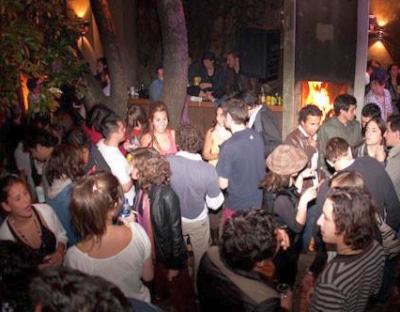
As safety becomes the norm and Colombia’s young begin to enjoy life around the city (and money) the way a generation ago never did, a burgeoning, dare we say it, hipster scene is emerging in Bogotá. (Full disclosure, I live in Brooklyn. I feel this is something necessary to disclose with regard to any discussion about “hipsters”.) In one such example, this week the NYT took a look at La Dayliciosa, a “part dance party, part rock show and part art opening” that began in 2007 as a result of the city’s law that forces bars to close at 3 a.m.
See, La Dayliciosa begins early in the day, offering revelers plenty of time to take in D.J.’s or a live band without fear of running into closing time. Pretension is hard to come by here, and the recurring party makes sure to put an emphasis on local music, highlighting the fact that the organizers are proud of their heritage and living in Bogotá. As one of the organizers notes, “We had very limited options when it came to going out, or doing much of anything in the city.” For those of you who’ve been there anytime recently, you know this is anything but the truth now.
The post A Look At Bogotá’s Hipster Scene appeared first on The Expeditioner Travel Site.
]]>The post Why You Should Visit Colombia appeared first on The Expeditioner Travel Site.
]]>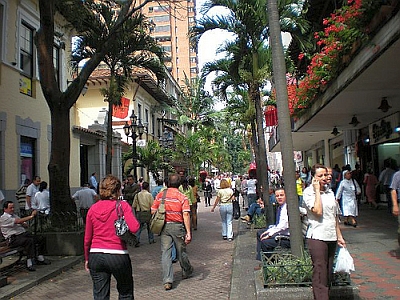
When I was reading the recent news reports about Colombia’s terrible rains and floods that have been ravaging the South American country for the last few weeks, it made me think back to my own trip there almost two years ago to the date. I was there in late November, and then too a weird rain system moved in — a once-in-a-lifetime phenomena I was told at the time — flooding the streets and washing out entire roadways.
But rain aside, Colombia’s still an amazing country to visit, not the least of which because of its notoriety for its thankfully lack of tourists. Of course, the reasons people have been hesitant to visit Colombia have been long gone for more than a decade now — drugs violence, kidnappings, political instability — and you’re far more likely going to run into an unforgettable Antioquian meal in a small cafe on the outskirts of Medellin than you are to ever stumble into a member of FARC.
Go Mad Nomad recently explored the country, offering up nine reasons why you should visit the country now, including the opportunity to explore some colonial gems — the Spanish began settling the country nearly 500 years ago — including Cartagena, Barichara, Villa de Leiva, Popoyan, Giron and Mongui. Go Mad Nomad also points out that Colombia is home to the Lost City (or Ciudad Perdida), which is increasing in popularity for travelers looking to avoid the crowds of Machu Picchu. Throw in the incredibly friendly and boisterous population, pristine Caribbean (and Pacific) beaches, and relatively cheap travel costs, and it’s a wonder there’s still a stigma attached to traveling there. Get there now before there’s a stigma attached to having never been.
The post Why You Should Visit Colombia appeared first on The Expeditioner Travel Site.
]]>The post Colombia’s Caribbean Coast appeared first on The Expeditioner Travel Site.
]]>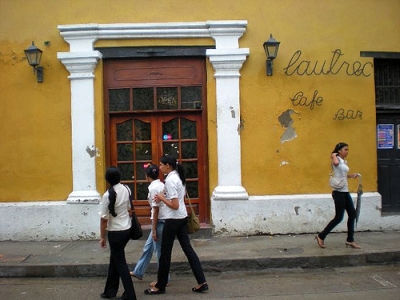
Colombia’s Caribbean coast is in the news big time this week, with article in both the Financial Times and the NY Times. Gone are the days when the region’s checkered history scared away tourists. Now, for better or worse (better if you’re a local depending on travelers), you’re more likely to run into a yacht-owning Colombian than a drug runner.
I’m not really sure what the significance of all the coverage is, other than the obvious fact that the face of travel to Colombia is changing, and changing quickly (as evidenced by the 17% uptick in travel there last year). A few years back the NY Times took a look at travel to Tayrona National Park, and this week they headed back to the region to stop in at Santa Marta, a sleepy coastal town who many would agree saw most of its best years back around the 17th century.
Many, that is, except those who’ve visited recently. I mainly remember flooded streets and empty beaches, but the city is starting to grow out of what many once saw, as the article points out, as simply “a stopover point for visitors looking to trek through Tayrona National Park or hike to the Lost City, a well-known archaeological site nearby.”
Now, steakhouses and coffee chains are opening up here. “’Until five years ago nobody would come here because of the guerrillas,’ said Michael McMurdo, a New York City-trained chef who recently opened a Mexican restaurant, Agave Azul, in Santa Marta. ‘While there is still some sketchy stuff going on, I like it here because it still feels real and Colombian.'” Which is true. I remember tinto men (coffee sellers) roaming the streets at the crack of dawn and fresh lemonade stands serving the morning commuters as they walked to work. There were scores of local mom-and-pop restaurants serving the amazing Caribbean-influenced food that people have been eating here for generations, and the some parts of the town felt like you had wandered into a colonial-era neighborhood at the height of Spanish power.
As an ex-pat is quoted at the end of the story: “The city is full of people going about their daily lives, going to work or selling things on the street with almost no interest in a foreigner walking around . . . Santa Marta is the real South America I was searching for.”
[image by Matt Stabile/Flickr]
The post Colombia’s Caribbean Coast appeared first on The Expeditioner Travel Site.
]]>The post Gabriel García Márquez’s Colombia appeared first on The Expeditioner Travel Site.
]]>
This week Cartagena, Colombia, is getting the “walk-in-the-shoes-of-“blank” treatment from the NYT, with a look at the city through the eyes (and hands) of Gabriel García Márquez, perhaps Colombia’s most famous artistic export (outside of Shakira). Though they note the author never really lived there for much of his life (his family moved there after his own short stint there), he now winters there and is sometimes seen sipping a cocktail at the nearby Sofitel hotel, or dining at La Vitrola, a cuban-themed restaurant specializing in Batista-era ambiance.
So how much did the man make the city, or was it the other way around? “It is a city so pregnant with the near magical that, when Mr. Márquez took a visiting Spaniard on a tour one day that included a Creole lunch and a stroll through the old city, it lowered his opinion of Mr. Márquez’s talents. The Spaniard told Mr. Márquez, as he would later record in an essay, ‘You’re just a notary without imagination.’”
The post Gabriel García Márquez’s Colombia appeared first on The Expeditioner Travel Site.
]]>The post Finding Colombia’s Lost City appeared first on The Expeditioner Travel Site.
]]>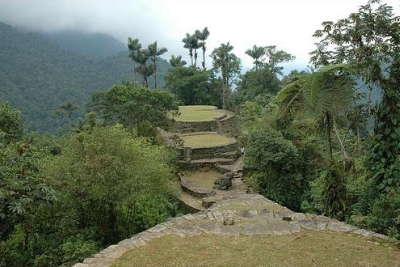
A trek into the jungle in search of Colombia’s “Lost City.”
Our group grabs the packs from the top of the Jeep’s rusty roof before we set off for Ciudad Perdida, or Colombia’s Lost City. Our guide, Tunyi, decides to begin the six-day trek by telling us about eight tourists who were kidnapped on September 15th, 2003, by the National Liberation Army (ELN) on the very trail we were hiking. “Three months they held them captive,” he tells us. “They were lucky to be released.” The three Australians in our group find this funny while the two boisterous Russians become quiet and pensive after I translate this bit of information for them. Perhaps Tunyi should have started by pointing out the names of some native fauna.
After the kidnapping incident, tourist treks to the city stopped until 2005. Though an air of danger still lurks on the forbidding trail, Colombia’s army now patrols the path, and according to our guide, the number of robberies have taken a dive. Within the first hour we pass a small group of soldiers wielding semi-automatic weapons. The Russians seem especially agitated by the troops, and they request in broken English that I ask our guide in Spanish their purpose.
We venture into Colombia’s Sierra Nevada mountain range along narrow and seemingly impossible trails in saturated air. After a few hours we have crossed the same river a dozen times as it snakes along our difficult path.
The jungle canopy offers no relief from the ruthless heat. I am shocked at the volume of sweat pouring from my skin. I realize way too late that I’ve overpacked by about 30 pounds. My 80-liter pack dwarfs everyone else’s diminutive daypacks. Dave Foster Wallace’s 1100-page novel, Infinite Jest, ranks at the top of my poor packing decisions. After one particularly grueling stretch of the trail, I consider ditching the book.
The trail is exhausting, but it is the exhaustion we have paid for. We came to feel our shoulders ache, our feet blister, and our sweat to pour from our bodies. We came for that little voice in our head that says, “you can do it,” to a skeptical body. Unlike the less strenuous trek to Machu Picchu, there is no bus option here. Barring helicopters, the only way to get to The Lost City is along an ancient trail once used by Tayrona Indians.
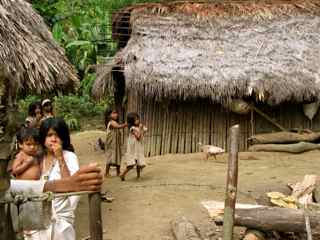 Teyuna, as the Tayrona originally called the city, was “found” in 1972 by treasure hunters. At the time, its location was already widely known to tribes living in the area. Founded possibly as far back as 800 A.D., it is believed that at its peak it was home to about 10,000 Tayrona. Unlike many of the magnificent ruins dotting Latin America, The Lost City is not just a story of what once was, but in many ways the story of what still is. Along the way, our trail leads us through small villages inhabited by the Kogis, the blood descendants of the city’s founders. They are still living in the same widely romantic way of their ancestors.
Teyuna, as the Tayrona originally called the city, was “found” in 1972 by treasure hunters. At the time, its location was already widely known to tribes living in the area. Founded possibly as far back as 800 A.D., it is believed that at its peak it was home to about 10,000 Tayrona. Unlike many of the magnificent ruins dotting Latin America, The Lost City is not just a story of what once was, but in many ways the story of what still is. Along the way, our trail leads us through small villages inhabited by the Kogis, the blood descendants of the city’s founders. They are still living in the same widely romantic way of their ancestors.
As cautious outsiders, we watch the inhabitants of these villages as they herd their children inside the huts while we pass, commanding them in one of the 100 dialects of their still-intact ancient language — a language they are reluctant to share with the eager anthropologists who come to study their way of life.
After eight hours, we reach the place where we will be spending our first night, under a thatch roof, hanging in hammocks. Our guides serve us a divine dinner of chicken, rice and fried plantains. But my hunger is such that high-school cafeteria food would have tasted as good.
The Russians, who initially were worried that they might not be able to fall asleep in a hammock, quickly find out that after a day of trekking on such trails, sleep is inevitable and intensely restful.
* * *
Either the second day is easier than the first, or my body simply has given up on feeling pain. I learn from our guide that all the villages along the way are part of one tribe, and that once a year in February they have a month of celebration in which they all meet to drink fermented fruit juices and perform various rituals.
At one point our guide stops and shows me a coca plant. It is hard to believe all the problems this little leaf has caused the world. He points off into the jungle to where he says he knows of a cocaine factory several kilometers off the trail. Unite States drug aerial fumigation is banned in this area, making it an ideal place for such illegal activities. He tells me that on the way back, for 20 dollars, he knows someone in the factory who will give me a tour. Apparently even the drug business wants tourism dollars these days.
When we pass through another village, he tells me that a Tayrona bride will spend her wedding night with the chief before having relations with her husband so that she can be taught how to love. It sounds like a good gig. I ask jokingly how I can become a Tayrona chief, only to be solemnly informed that because I am a gringo, I would never be allowed into the tribe.
* * *
In the afternoon on the third day, we cross the river for the last time and see moss covered stone steps tucked away under the foliage. These are the beginning of a stairway of over 1,200 steep steps leading straight up the mountain to The Lost City. Before my foot falls on the first step, a Kogi, dressed in his traditional white garb, emerges from the steps and ignores me as he disappears into the jungle. I look at the prints his bare feet have left in the mud. My heart jumps and I see meaning spanning a thousands years in those footprints.
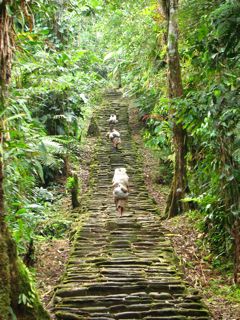 With my pack weighing me down on the slippery stairs, I almost fall several times, a mistake that could have disastrous consequences in this remote area. The stairs are by far the most difficult obstacle yet. Aching legs are being commanded up narrow stairs cutting into the steep mountainside. My cardiovascular system demands a rest, but I ignore its plea. This has become my Mecca, and I will make it up in one uninterrupted jaunt.
With my pack weighing me down on the slippery stairs, I almost fall several times, a mistake that could have disastrous consequences in this remote area. The stairs are by far the most difficult obstacle yet. Aching legs are being commanded up narrow stairs cutting into the steep mountainside. My cardiovascular system demands a rest, but I ignore its plea. This has become my Mecca, and I will make it up in one uninterrupted jaunt.
Heaving, I reach the top. Surrounded by ancient stonewalls, I have attained the sky — the ancient stomping grounds of the Tayrona. A waterfall can be seen on an adjacent mountainside flowing, it seems, from the clouds. With my mind’s help, I see much more than stones and a stunning view. I imagine answers to questions we may never know.
Where did the inhabitants of the city go? Unlike many other ancient cities, the Spanish never came here. As the conquistadors settled around the Caribbean coast, the people here simply left and were never heard from again. Some speculate that the direct descendants of the city’s inhabitants are still thriving somewhere in a distant, undiscovered jungle haven.
How the city was built is another mystery. From samples of the rocks, archeologists have concluded that some sort of acid was used to cut perfectly shaped blocks. Because of a potential commercial value, jungle plants have been collected in throngs to find the acid, but it, like the city’s inhabitants, seems to have disappeared into the jungle forever.
Our group spends the night in hammocks atop the city in quiet contemplation. We are alone to pass the night here in the city — something unheard of in similar sites across Latin America. As night insects begin filling the air with their sound, our conversations wane and then end. The ancient city seems to have given everyone a lot to think about. For all of us, it is much more than stacked stones on a mountainside. It is a transient glimpse of a former world that in a small way seems to live again tonight.
* * *
What to bring:
A good pair of shoes, several pairs of socks, long pants, shorts, a t-shirt, a jacket or sweater, and a water bottle. The guides will carry food for you and the river water is safe to drink. Even if it does not rain, expect your perspiration to soak your clothes within minutes. Hammocks are provided for you, but if you are sensitive to the cold, you will want to bring a blanket or sleeping bag.
How to get there:
Going without a guide to the city is strictly prohibited, and you must book a tour with one of the two companies authorized to bring groups: Turcol Travel Agency or Sierra Tours. Both have offices in Santa Marta and Sierra Tours has a second office in the dive town of Taganga. For the six day guided trek, both companies charge about $240.
Where to book a tour:
Sierra Tours is more sensitive to making the Trek eco-friendly and respecting the local tribes along the way. In Taganga, Colombia: Calle 17 1-80. In Santa Marta, Colombia: Calle 22 16-61.
All tours are conducted in Spanish.
Contact information:
Sierra Tours
Phone: 5-421-9401 / 317-417-1797
E-mail: info@sierratours-trekking.com
Website: www.sierratours-trekking.com

About the Author
 Luke Maguire Armstrong lives in Guatemala directing the humanitarian aid organization, Nuestros Ahijados. His book of poetry, iPoems for the Dolphins to Click Home About (available for sale on Amazon.com) is especially enjoyed by people who “don’t read poetry.” (@lukespartacus)
Luke Maguire Armstrong lives in Guatemala directing the humanitarian aid organization, Nuestros Ahijados. His book of poetry, iPoems for the Dolphins to Click Home About (available for sale on Amazon.com) is especially enjoyed by people who “don’t read poetry.” (@lukespartacus)
The post Finding Colombia’s Lost City appeared first on The Expeditioner Travel Site.
]]>The post Lonely Planet’s Top 10 Countries For 2010: And The Winner Is . . . appeared first on The Expeditioner Travel Site.
]]>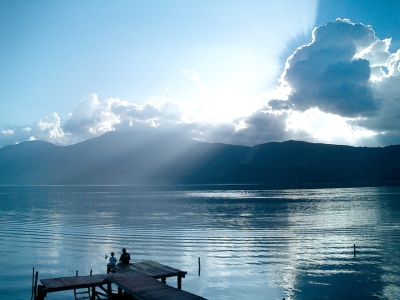
Lonely Planet’s doling out accolades to these ten countries as being very topping, with El Salvador being the toppingist of them all. Okay, they don’t really elaborate as to what this list mean, other than being the “hottest countries for next year,” but I assume they mean destinations that are, or have been, under the radar and are just coming into their own as hot spots for travelers. Which usually means one thing: Get there now before they’re firmly on the tourist trail.
Rounding out the top five are Germany, Greece, Malaysia and Morocco. And at number 10, experiencing a little Obama bounce, the U.S.A., which given the likelihood of a an anemic dollar for the near-term future, will likely be at the top of the list for many visitors, especially those carrying the enviably strong euro.
So what’s missing here? I may sound like a broken record, but let’s give a shout out to Colombia, a country whose culture and diversity, not to mention accessibility, makes it a great “top” country in 2010. A few of my own honorable mentions: Panama (have you seen how cheap it is to fly there in the winter?), Ireland (see Panama), and Namibia (everyone I met in Africa who was visited the country raved about the outdoor adventures that can be had there).
The post Lonely Planet’s Top 10 Countries For 2010: And The Winner Is . . . appeared first on The Expeditioner Travel Site.
]]>The post Colombia Calling (Part Two) appeared first on The Expeditioner Travel Site.
]]>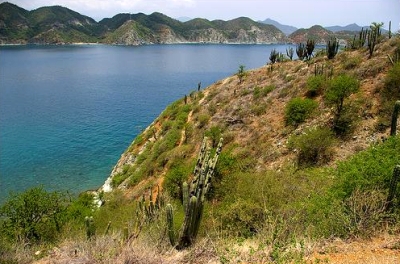
The easy part of about Playa Grande is falling for it immediately. The hard part? Getting there.
By Matt Stabile
I STUCK MY HEAD OUT THE OPEN DOOR OF THE BUS and looked down a steep cliff wall that descended into a wide bay. The public buses in Colombia are usually beat-up looking affairs, with rusty fenders, faded stripes painted across their bodies, and, as is customary across many parts of Latin America, manned by both a driver and an assistant who hangs bravely near the door and collects the fares as they are passed up to him after passengers get a chance to settle in.
This particular assistant didn’t seem fazed the slightest as he stood precariously near the open door, clinging to a bar above the windshield and staring lazily out the door of the bus, his foot hanging in the warm breeze, several hundred feet from the ground. We were crossing over the small row of hills that separate Santa Marta from Taganga, a sleepy fishing village on a bay that, incidentally, has become the region’s capital of scuba instruction. I was not heading there to take advantage of the diving but rather as a jumping-off point to head one beach further to Playa Grande, a secluded stretch of sand with an esteemed reputation for beauty.
My roommate back at the hostel, a South Korean in his mid-to-late-twenties (a description that could easily be applied to nearly all of the travelers I encountered in Colombia — the mid-to-late-twenties part, not South Korean), was there taking some time off from work after being let go from an IT job in Seoul. He decided to pack up his things — which from the looks of his messy bed and crowded shelf next to his bed, consisted mainly of scuba instruction literature and small, portable electronic devices — and stake out a bed at this hostel for roughly $5 a night while he attended one of Taganga’s many scuba schools.
“How’s the beach at Taganga?” I asked after I had returned one afternoon from exploring Santa Marta. I figured he’d know all of the beaches around here by now, especially since he’d been here for well over a month. Also, his scuba school was about a stone’s throw away from the town’s bay.
“Yes, I’ve heard it’s good,” he said reassuringly. “You will like it.”
“You heard it’s good?” I asked, confused. “Haven’t you been?”
“No, we are still studying,” he replied matter-of-factly. “Diving doesn’t come until after we pass the tests.”
I looked at him with a blank stare but decided to leave it at that.
As our bus got closer, we passed by several of the scuba schools that lined the road leading into town. I hopped off at a stop near the end of the beach and made my way along the crowded shoreline.
The entire stretch of sand was cramped with various street food vendors, fishing gear, and lines of rope securing the fisherman’s boats to the palm trees on the sand’s edge, creating a giant, elaborate obstacle course for anyone hoping to cross the beach. It was barely past 7 a.m., and even the fishermen looked like they weren’t used to being up that early. As I walked, the sand was getting caught between the leather straps of my sandals and rubbing against the fresh wounds on my feet I had received from snorkeling the day before.
“You want a ride to Playa Grande?” a man asked off-handedly as I reached the end of the beach. He was standing in a boat and was pulling up a line of rope from the water. “I take you there by boat, drop you off, and come back later.”
I was weary of being ripped-off or scammed, which, incidentally, almost never occurs in Colombia, or at least not even close to the frequency that it does in many parts of the rest of the world, including back home in New York. He was around my age and height, and he was wearing a beat-up looking pair of plastic sandals that looked like the kind they sold at dollar stores. (Later that day, I would offer my pair of boogie board shoes to him since I had little use for them after then. As I drove out of town later, I spotted him standing on the corner and chatting with a group of friends, my bright, orange shoes on his feet.)
“No, thanks. I am taking the path,” I said, gesturing to a withered strip of clearance at the bottom of a steep hill that may or may not have been the beginning of a path. He raised his eyebrows and said nothing, continuing to organize his line of rope.
A man standing in a boat next to us who had been listening raised his eyebrows too after hearing this, then went back to poking around the hull of the small, metal vessel with a screwdriver. He looked about the same age as us and the two boats would have been hard to differentiate save for a large orange bucket that rested on the edge of his boat’s starboard side, assumedly for holding fish, but also likely used for the occasional bailing out of sea water. The other man’s boat had no bucket.
45 minutes later — 35 minutes after I was supposed to have reached Playa Grande according to my guidebook — I was still making my way along the path. With my shirt I blotted out the massive amount of sweat that had collected on my forehead and was burning my eyes as it oozed down my face. The glaring sun, a sight I had rarely seen during the previous week here in the country was furiously at work baking the shrubby landscape around me.
I looked down the sharp hillside and, as if it was trying to tease me with its proximity, I could see Playa Grande splayed out far below me. In between me and the beach, a massively thick collection of shrubs, gnarled trees, and, for good measure, a tall, rusty metal fence lay. Maybe if I had been wearing something a little more protective than a thin t-shirt and swim trunks, or had I been carrying something more akin to a machete than a pair of goggles, I could have attempted to make my way through, cutting the brush and scaling the fence, finally arriving at my destination. But, given my situation, I was stuck with the hope that the path that I had been traveling on for what seemed like hours would eventually lead down to the beach.
A few minutes back, after I had started out on the path, I’d passed a couple of fisherman who were carrying a long pole by either ends with various species of aquatic life hanging from it by wire. We said “good morning” to each other and went our separate ways. Since then I had yet to see another soul.
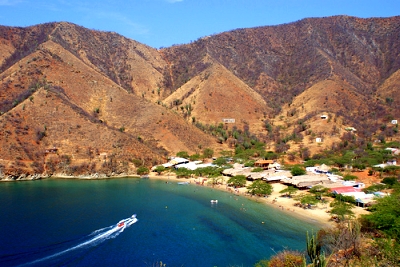 Ahead of me the path seemed to continue on forever into the distance; a distance that angled sharply away from the beach that I was aiming for and seemingly back towards the far side of the hill where I had begun.
Ahead of me the path seemed to continue on forever into the distance; a distance that angled sharply away from the beach that I was aiming for and seemingly back towards the far side of the hill where I had begun.
“Maybe if I go a little further I would see that the path splits and heads down to the beach,” I thought to myself. Of course, this is exactly the same thought process that people who have gotten lost hiking in the mountains and find themselves caught in a heavy blizzard say to themselves shortly before they collapse and die, minutes before a rescue team shows up, or right before the storm breaks just enough for them to catch their bearings. As the rescue team picks over the frozen remains, you can imagine them always saying, “If only they’d stayed put just a little longer.”
Naturally, I trudged on.
After a half-hour, I came upon a metal electrical transformer that was sitting in the middle of the path. I climbed on top to try to get a better vantage point of my location. Just ahead, the path snaked upwards to the peak of another hill and disappeared behind its back. To one side I could see Taganga, a distance that looked to be about an hour’s hike. On the other side I could still see Playa Grande, looking just as difficult to reach as before.
As I hopped down from the transformer, I heard two men behind me speaking to each other. Abruptly they stopped, as if being interrupted. I looked back and saw two figures that had crested the hill in the distance ahead. Their caps were pushed down over their eyes. They were carrying tattered backpacks and wearing boots caked with dried mud. The sun was high in the sky behind me, backlighting me, so I probably appeared nothing more than a shapeless blob to them, but as I stood there looking, I could see that one of the men had caught sight of me.
We stood there, watching each other — assessing each other — for what seemed like minutes. Neither of us made an attempt to move. Finally, as if coming out of a trance, I quickly turned around and scuttled forward, ignoring the sharp reeds scratching against my exposed feet.
Amazingly, it took only about 20 minutes to get back to the beginning of the trail. I must have been quite a sight as I emerged. By this time I was completely soaked with sweat, the color of my shirt transformed from a light gray to a deep black, my hair plastered to my forehead with perspiration, and my feet and lower legs covered with brambles and small scrapes from the low growth along the path. Even as I backtracked, I still couldn’t make out where the path could have led directly to the beach in the “15 minutes” that I had read it would.
The same man in the boat that I had spoken to earlier was still there, this time sitting on the edge his boat and looking contently at his pile of rope, as if admiring his handiwork.
“We go,” I told him as I looked behind me to see if anyone had followed me. I threw my bag into the boat and hopped in. He started up the engine and we roared off into the bay.
“Playa Grande, no good coral there,” he said as we chugged out into the bay. “I know where you see much more.”
I took his word for it and we sped along, out of the mouth of the bay, past a second beach, and finally to a rocky cape jutting out from the shoreline. I threw on my mask and dived below as the driver settled himself into the bow of the boat, chatting with another boat operator parked next to us. The coral was quite a bit deeper here than what I saw the day before in Tayrona, which made it more accessible to swim around and explore, but also made it noticeably less colorful and easy to see.
At one large piece of brain coral, I watched as what looked like a giant white millipede the size of a rat climbed up the face wall. I curled myself into a ball and sunk to the sea floor and watched as a school of small orange fish traveled above me. A fat, bluish colored fish emerged from a crack in a piece of coral I was examining and swam up to the front of my mask as if trying to admire itself in the reflection. I remained as still as I could until he grew bored and swam off in the opposite direction.
After about an hour the driver stuck his head beneath the water and motioned for me to come up. I climbed back on board and we sped back over to Playa Grande to grab a soda and relax for a little while.
“You went on the path?” he asked, as we sat on plastic chairs at the edge of the beach beneath the shade of a palm tree, sipping from tall bottles of Pepsi.
I nodded yes. “But I had a little trouble.”
“Very dangerous,” he said ominously. “Yesterday, two people robbed there. Took their wallets, cameras, everything. Happens a lot.”
“Really?” I replied, finishing off my drink.
“But mostly it is only fisherman that walk it. It’s a very old path.”
We climbed into the boat and headed back towards Taganga. I was feeling worn out from the heat, my feet were throbbing from the various abrasions from the hike and the snorkeling the day before, and the sun was turning the back of my neck into an unforgiving shade of red. I wouldn’t have done it any other way, but I was ready to return to dry land and to head back down the coast to Cartagena, my next and final stop of the trip.
A thin layer of clouds passed over the sun and the entire sea faded into a brilliant shade of turquoise beneath the green hillsides. I leaned over the edge of the boat and let my hand skim over the water as we glided along. We rounded the cape and I looked up and saw two hikers, both men, slowly making their way down the same hill that I had been hiking earlier. The sun had had now shifted to an angle behind the hill, casting a large shadow over us. The path looked vaguely similar to the one I had been on, except at this point it led lazily down from the hills above Taganga to the edge of Playa Grande. No sign of overgrowth. No sign of faded pathmarks. No sign of dead-end tributaries.
The driver waved to them and nodded as we passed below. They raised their arms slowly and waved back at us; dark outlines of figures silhouetted against the murky light of time.

Read “Colombia Calling (Part One)” Here
About the Author
 Matt Stabile runs TheExpeditioner.com. You can read his writings, see his videos, purchase the book he co-edited or contact him via email at any time at TheExpeditioner.com.
Matt Stabile runs TheExpeditioner.com. You can read his writings, see his videos, purchase the book he co-edited or contact him via email at any time at TheExpeditioner.com.
The post Colombia Calling (Part Two) appeared first on The Expeditioner Travel Site.
]]>The post Colombia Calling (Part One) appeared first on The Expeditioner Travel Site.
]]>
Maybe secluded bays and pristine beaches aren’t the first things that pop into people’s head when they think of Colombia, but a trip to Colombia’s Caribbean coast reveals just that. And the best part? No tourists.
By Matt Stabile
AS I LOOKED OUT THE BUS WINDOW AND INTO THE NIGHT SKY, I could see flashes of lightning igniting the dark, colorless clouds lingering high above the Caribbean Sea, portensions of things to come. It was Friday night. Cumbia music was blasting from a radio hanging by a wire above the driver’s head. Behind me a teenage girl was meticulously applying makeup with the aid of a small compact mirror. Two seats in front of me, a group of young Colombian men were drinking from an open bottle and joking around with each other. I peeled my shirt away from my chest, damp from a combination of a slight drizzle and the tropical humidity that had blanketed my body the moment I stepped off the plane, and I couldn’t have been happier. I had traveled here to Colombia’s Caribbean coastline to visit its famously beautiful and remote beaches — beaches whose mythic-like images were planted enticingly in my mind by travelers during cold, rainy nights in Bogotá hostels and Medellín cafes; usually described in hushed tones, like the disclosure of the whereabouts of a lost city that few had seen.
It was only fitting that the rain began to fall the minute that I stepped off the plane. At first it was a light drizzle, but as the hours wore on, the rain progressed into what I would soon learn was an once-in-a-decade “weather phenomena” that, during the course of my stay along the coastline, would cause rivers to overflow, shantytowns to flood, city streets to become deluged and hidden beneath torrents of water flowing from the nearby mountains, and for me to seriously question what vendetta had I with the gods that was causing this storm to strike during the exact period of time that I was staying there.
The good thing about rain, particularly the kind that falls in the warm, humid months of November and December here, is that it’s still far better to be caught in than, say, a snowstorm in the icy, frigid streets back in New York where, had I been at that exact moment, I would certainly not be wandering around in a pair of swimming trunks and sandals, stopping into various shops, and lounging on the beach with a concoction of freshly squeezed coconut and orange juice served in a plastic mug shaped like a coconut shell.
“When do you think it ends?” I asked a bored barista the next morning, shortly after I had ordered my third straight cup of coffee.
“The rain,” I added, as if to clear up any misconception as to what I was referring to, despite the near biblical-like scene unfolding just outside the mall’s doors.
After checking into my hostel the night before, I’d woken up to the downpour, and, after getting bored hanging around my newly swamp-like neighborhood, I decided, against my better judgment, to heed the advise of several locals and take a taxi the short distance to the BuenaVista Mall, a large, entirely out-of-place structure that looked like it had been heli-vac’d from Southern California and dropped incongruously in the outskirts of northern Colombia. Given the rarity of these types of large, commercial ventures in the less populated areas of the country, everyone here seemed to be oddly proud of what would be pedestrian in other parts of the world (including Colombia’s own larger metropolitan areas).
To add insult to injury, I arrived wearing what I had put on that morning: a pair of blue swimming trunks, t-shirt, leather sandals, and a bag strung over my shoulder containing a beach towel, snorkel mask, and a newly purchased bottle of sunscreen lotion, all eagerly packed at the crack of dawn in the anticipation of my sojourn to the beach.
“It’s a weather phenomena,” the barista answered in a defeated manner. “It happens once a decade.”
“Yes, I heard,” I mumbled to myself in English.
In fact she was roughly the sixth person that day who had used the word “phenomena” to describe the weather, including, but not limited to: the manager at my hostel, the tinto-man outside my hostel (men who roam the streets during the early morning hours dispensing dixie-cup size coffees from a basket of thermoses), a clerk at a tour company around the corner, the cab driver who had taken me to the mall, and a maintenance man here in the mall who was changing light bulbs outside a greeting card shop with whom I had desperately struck up a conversation after making my third pass through the closed food court.
And that pretty much ended our conversation about the weather. We discussed Colombian coffee (she informed me that the best of it gets exported out of the country, so don’t expect to find great coffee readily available as I travel the country), and she told me about what it was like working there (the pay was steady and there was air-conditioning, two factors that made her job at least tolerable until she finished school).
Needless to say, it gets very hot in Colombia. The Equator runs through the southern portion of the nation, but the country’s most populous cities — Bogatá, Medellín — are high in elevation and vary between spring-like conditions (particularly Medellín) to rainy, cooler conditions (Bogatá). But a short flight or a day-long bus ride north to the coastline brings you smack in the middle of a truly Caribbean, tropical environment. A popular vacation getaway for Colombians, the stretch of coastline that runs from the border with Venezuela to the historic port town of Cartagena — located roughly halfway between the borders with Venezuela and Panama — contains some of Colombia’s most popular beaches, as well as some of its most scenic getaways.
After countless recommendations from other travelers earlier in the trip, I decided to come to Santa Marta, a medium-sized town located in the northeastern part of the country. Santa Marta is a convenient and popular place to stay for those heading into Tayrona National Park, the vast, mountainous national park covering roughly 300 square kilometers along the coastline that stretches deep into the mountains. Once home to the Tairona people — a native group that dominated the area before the Spanish arrived in the 16th Century — the park was considered too dangerous to visit up until a few years ago due to the presence of the various militant groups that Colombia is all-too-famous for.
But, in the last few years, just as the rest of the country’s security situation has drastically approved, so too has safety in the park, and the number of visitors has increased precipitously. (In fact, I was advised the only dangerous parts of Colombia visitors should avoid are in the southern portion of the country where the wild jungles of the Amazon are ideal hiding grounds for militants.)
Unlike the other, more well-known beaches and resort towns along the coastline, the park itself is almost entirely undeveloped, except for the few dirt roads that begin about 30 miles on its outskirts and wind their way to one of the ten or so beaches accessible to travelers. On the western part of the park are Bahía Concha and Bahía Neguanje. Though physically closer to the cities to the west, the beaches on this stretch of the park are actually the hardest to reach, requiring an hour-long drive on dirt roads and usually involving boat connections. To the east are the more accessible but much more visited beaches. Most travelers usually find there way to Playa Cañaveral, where it’s a short hike one beach over to Arrecifes and then an even shorter hike over to gorgeous Cabo San Juan de la Guía, a small beach village where hammocks are rented out for a few dollars a night and the day can be spent hiking inland to Pueblito, the remains of a Tairona village.
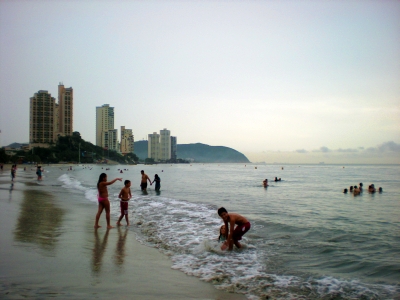 To get to the less-visited beaches in the west, your best bet is to shell out the money and sign-up with one of the many tour operators that have set up shop along the coastline in Santa Marta for, at the very least, the hassle-free transportation.
To get to the less-visited beaches in the west, your best bet is to shell out the money and sign-up with one of the many tour operators that have set up shop along the coastline in Santa Marta for, at the very least, the hassle-free transportation.
On my first full day in the region, after stopping by El Rodadero — a touristy beach-town south of Santa Marta, home to tall, pastel-colored hotels towering over the bay, and where I had eaten lunch under the protection of a grove of palm trees as the rain fell on the water — I wandered along the strip of shops along the Santa Marta beach where I came across a company that was organizing a trip to Bahia Neguanje early the next morning.
“Do you think it’s going to clear up by tomorrow?” I asked the guide behind the counter, looking out the window at the gray sky, hoping the trip wouldn’t be canceled.
“It’s a weather phenomena, you never know,” she replied. Yes, I had heard.
*
The next morning a beat-up Daihatsu van pulled up to the corner, packed full with a group of visitors from Medellín. We exchanged pleasantries — “Come estas?” (Bien, un poco frio); “De donde eres?” (New York City, Medellín) — then made our way through the narrow streets and out of town, slowly gaining elevation as we drove further into the surrounding mountains.
“How do you like my town Matchieu?” Julian, our guide, asked during a lull in his telling of the city’s history.
“Very much,” I replied. “But too much rain.”
 “Ha! It is not always like this. Only once in a decade!” he shouted and slapped me on the back like I had just told a hilarious joke. He paused for a moment, collecting his thoughts, then launched into a recitation of the famous Colombians who were born in Santa Marta.
“Ha! It is not always like this. Only once in a decade!” he shouted and slapped me on the back like I had just told a hilarious joke. He paused for a moment, collecting his thoughts, then launched into a recitation of the famous Colombians who were born in Santa Marta.
A half-hour later, we suddenly veered off the highway and onto a dirt road leading into the park. After a short stop at the park entrance where we ponied up the entrance fee (and where I loaded up on the various sweets sold by the women with baskets of homemade treats balanced precariously on their head), we pushed further on into the park. A steady dose of year-round rain and the warm, humid climate combine to create the perfect conditions for dense vegetation, and looking out the window I could barely see a few feet beyond the beginning of the jungle’s edge before the deep greens dissolved into blackness.
Julian described the wide variety of species of mammals, birds, and reptiles that call the park home, including various monkeys, toucans, and blue crabs that like to travel in masses, oftentimes causing cars to wait patiently as the crustaceans make there way from one side of the road to the other.
We crested a hill and began to descend downward in the direction of the sea. We were constantly forced to veer from side to side to avoid the many trees and plots of land that littered the road as a result of the previous night’s torrent. At one point we had to stop as the driver got out and moved a giant branch that was too big for us to drive around. As we were watching him tug the fallen branch to the far side of the road, a woman in the car shrieked and pointed out the window. Sitting contently on the side of the road, a small monkey had appeared, apparently enjoying the show as much as we were.
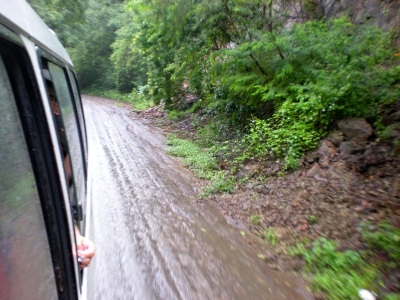 “Matchieu!” Julian cried out, slapping me once again on my back. “I bet you don’t see that very much in New York. Ha!”
“Matchieu!” Julian cried out, slapping me once again on my back. “I bet you don’t see that very much in New York. Ha!”
We continued on down the road and, 20 minutes later, escaped out from under the canopy of brush that had been towering over our heads. Before us emerged a large bay beyond a mushy beach, where the fresh rainwater was collecting into newly created pools.
“This is where we catch our next ride,” Julian announced, pointing to several small boats that were sailing in the opposite direction from us. “But for now, we wait.”
We emptied out of the stuffy van and huddled together beneath a thatched hut near the edge of the beach. We watched as giant drops of rain fell into the steamy bay. A half-hour later our transports returned and we loaded into the rickety, aluminum boats and headed out into the bay and out around a cape. The wind was blowing steadily across the water and the waves were picking up the boats like invisible hands and slamming them back down against the surface, spraying large sheets of water over us.
In my boat sat a large family consisting of two sets of grandparents, a brother-in-law, a young couple, and sitting next to me, their five-year-old son who, by the look on his face, seemed busy mentally storing this experience in his mind so as to be able to relate it to his therapist later in life. He shuddered underneath a giant life preserver that covered his entire torso down to his knees, his head barely emerging from the mass of orange foam that surrounded it. He stared down at the puddles of water collecting beneath his sandals as drops of rain streamed down his face. I picked up one of the extra life preservers and held it above his head for a little protection from the rain.
As we rounded the cove, the pounding rain suddenly began to let up and the clouds thinned, revealing sloping, jade-colored mountains surrounding us. The small hilltop peaks were shrouded by low clouds crawling across their faces.
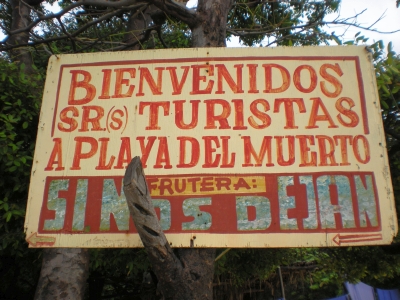 “Welcome to ‘The Beach of the Dead,’” Julian announced as we jumped out of our boats and into knee-deep water. “Or what the local government has tried to rename, ‘Crystal Beach.’”
“Welcome to ‘The Beach of the Dead,’” Julian announced as we jumped out of our boats and into knee-deep water. “Or what the local government has tried to rename, ‘Crystal Beach.’”
I later learned that the original name was derived from the fact that the Taironas once used the beach as a sacred burial location for their dead — hence the name — but the beach was officially renamed to a slightly more palpable moniker in an effort to promote tourism. I suppose “Beach of the Dead” doesn’t have the same allure for prospective tourists as “Crystal Beach.”
A woman from the small village that called the beach home was eagerly waiting for us at an open-air hut. The beach is home to a group of residents who make their living from groups like ours, preparing large feasts while the visitors frolic in the water. As each of us emerged from the boat, we waddled over to her on our sea legs and placed our lunch orders, choosing from a selection of freshly caught fish laid out before us on a wooden table. I picked one out, then asked Julian where the best coral was. He pointed towards the end of the beach and I scurried away.
I dove in and quickly found myself transported to a different world. All around me was a colorful forest of elk horn, giant brain and star coral. A variety of fish were excitedly swimming about, diving in and out of the nooks and crannies created by the underwater growth. A yellow-spotted French angelfish swam lazily by my face, then became engulfed within a large school of tiny minnows heading in the opposite direction. I sank to the sea floor and watched as a blue surgeon, a blue-colored fish roughly shaped like a large dinner plate, passed overheard, its yellow perimeter outlined by the sun rays creeping through the water’s surface.
I floated back to the surface and let my body bob like a piece of driftwood, letting the tide gently toss me back and forth along the beach like an eager guide showing me the underwater sights.
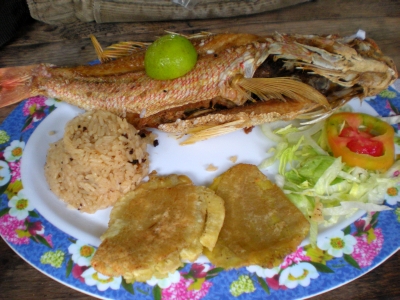 Two hours and several large lacerations across my exposed feet later, I trotted back to the collection of huts where a large plate lie, piled high with freshly grilled fish, rice cooked in coconut milk, and fried plantain. I sat down next to a couple from Medellín who were now living in London. She had just given birth to their third child and her husband had taken her here as a sort-of postnatal celebration.
Two hours and several large lacerations across my exposed feet later, I trotted back to the collection of huts where a large plate lie, piled high with freshly grilled fish, rice cooked in coconut milk, and fried plantain. I sat down next to a couple from Medellín who were now living in London. She had just given birth to their third child and her husband had taken her here as a sort-of postnatal celebration.
“What do you think of our country?” the husband asked me after taking a slug from a bottle of Corona.
“Amazing. Beautiful,” I answered, running out of cliched adjectives. “But, a little too much rain.”
“Yes, it’s a phenomena,” the wife said. “But I never seen it happen before. You are lucky!”
How right she was. I dug my bare toes into the sand, took a drink, and looked up at the now empty beach. Our boats were riding lazily up and down on the incoming waves and the sun, now on its afternoon trajectory downward, was now shining furiously down upon on the bay as if making up for lost time. All was forgiven. No hard feelings.

Read “Colombia Calling (Part Two)” Here
About the Author
 Matt Stabile runs TheExpeditioner.com. You can read his writings, see his videos, purchase the book he co-edited or contact him via email at any time at TheExpeditioner.com.
Matt Stabile runs TheExpeditioner.com. You can read his writings, see his videos, purchase the book he co-edited or contact him via email at any time at TheExpeditioner.com.
The post Colombia Calling (Part One) appeared first on The Expeditioner Travel Site.
]]>The post Get Lost With A Lost Girl In Colombia appeared first on The Expeditioner Travel Site.
]]>One of the hard working ladies from “The Lost Girls” is/was in Colombia recently, blogging her way through the northern stretches of the country. Her latest dispatch finds her taking a side-trip to Santa Marta where she lounges on the beaches in Santa Marta and soaks up some rays.
Though mentioned in passing in her article, the real reason to visit Santa Marta is not for its beaches (a little touristy, a little bland) but as a place to stay so you can strike out for Tayrona National Park, Colombia’s renowned reserve containing beautifully secluded, pristine beaches where you can snorkel, eat fresh fish caught earlier that morning, and relax and enjoy your time hours from the closest hotel. Given that the park is made up of isolated beaches and coves accessible by a single road, you could easily spend weeks just trying to see all of the park’s different sites. My advice: sleep in Santa Marta, spend your time exploring Tayrona.
One note on this piece, what really stuck out for me was the fact that she was staying at the Sofitel in Cartagena (I think, she may have just been using their concierge). Though amazingly luxurious, it just seems a little odd given that this is a city where a pretty okay room can be had for as little as $10 a night (hot water may be lacking, but when looking at rates of over $300, I’ll stick with the budget hotels). Besides, the real attraction is the city itself, and as much time away from your lodgings is highly recommended. Or maybe things over at Lost Girls are going the Twitter route and the ladies have a few extra dollars to spare, in which case, Sofitel away.
The post Get Lost With A Lost Girl In Colombia appeared first on The Expeditioner Travel Site.
]]>The post TheExpeditioner Guide to Colombia’s Caribbean Coast appeared first on The Expeditioner Travel Site.
]]>Here’s a little something I put together with some extra footage I had from my time spent on Colombia’s Caribbean Coast. Initially I was going to combine the above footage with my Cartagena video to make one “Colombia Caribbean Coast” video, but I ultimately decided to let Cartagena have its own video and to make a short about the few days I spent near the Venezuelan border at some of Colombia’s most renowned beach spots.
Colombia’s Caribbean Coast has some of the best, as well as some of the most secluded, beaches in the entire Caribbean. In this video I visit Santa Marta, the traditional jumping-off spot for treks into famed Tayrona National Park, sail to Bahia Neguanje and to the Beach of the Dead, and finish off in the popular beach getaway of El Rodadero.
For the rest of my videos from Colombia click here.
The post TheExpeditioner Guide to Colombia’s Caribbean Coast appeared first on The Expeditioner Travel Site.
]]>The post Blogging Colombia For Carnival appeared first on The Expeditioner Travel Site.
]]>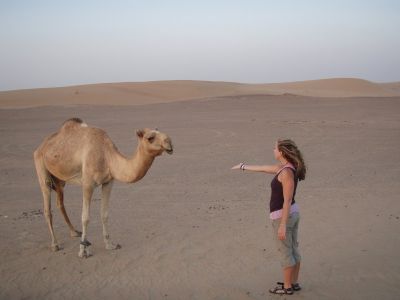
Amanda, over at Jaunted, is blogging her trip down south to Colombia (sound familiar?). I’m looking forward to following this trip. I don’t know why it is, but don’t you always like to hear about someone else’s trip to somewhere you’ve recently been?
I’ve heard a lot of other travelers say this too, and I’m not sure why this is. Either you’re curious to see how different a place can be when seen through someone else’s eyes, or you’re curious to see if they ended up having a better (or worse) time than you — in which case you can either be jealous (or happy). She seems to be seeing things similarly as I did so far, so no difference there, and she seems to be having a good time, and I’m extremely happy for this, so maybe it’s more of the former than the latter. Of course, it’s late February and she’s going to be down there during Carnival; when I was there a giant cold front was dumping a torrential amount of rain — let’s see how long I last following her trip.
The post Blogging Colombia For Carnival appeared first on The Expeditioner Travel Site.
]]>